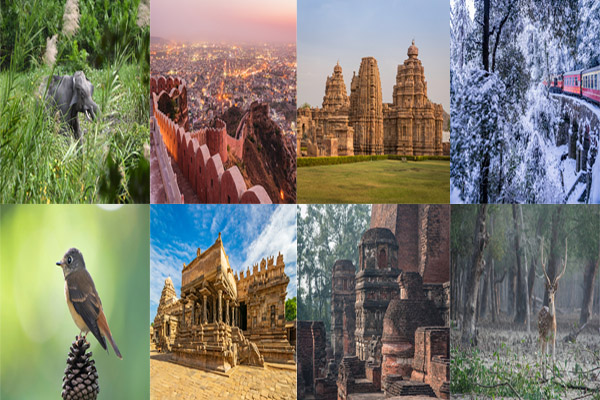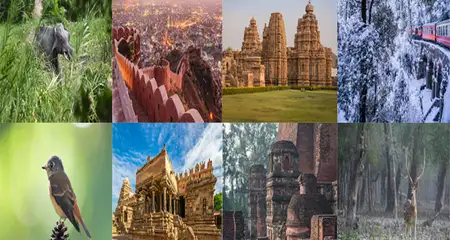India is a beautiful and diverse country, known for its vibrant cultural heritage, eye-catching architectural gems, and interesting landscapes. No wonder it boasts so many stunning UNESCO World Heritage sites spread across different states and union territories. Apart from the widely popular Taj Mahal, Sun Temple, Qutub Minar and Ajanta-Ellora Caves, there are many more cultural and natural sites in the country that are a part of the UNESCO World Heritage Sites list. After the latest additions in July 2021, there are a total of 40 UNESCO Heritage Sites in India. Out of these, 32 are cultural, 7 natural and 1 is a mixed site.
UNESCO World Heritage Sites in India
Cultural
1. The Taj Mahal, Uttar Pradesh
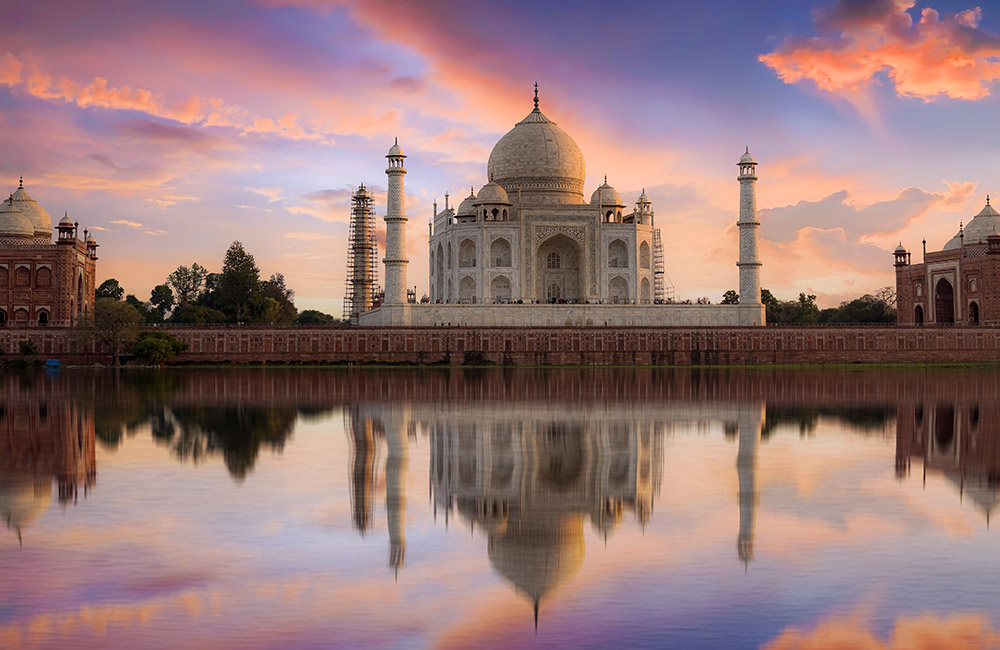
The Taj Mahal | #1 of 40 in the list of UNESCO World Heritage Sites in India 2021
One of the Seven Wonders of the World, the Taj Mahal was declared as a UNESCO World Heritage Site in India in 1983. This stunning white marble mausoleum on the banks of River Yamuna is surrounded by a beautiful garden. It was built by the Mughal emperor Shah Jahan in the 17th century in the memory of his beloved wife, Mumtaj Mahal.
The structure of the monument boasts typical Mughal architecture with elements of Indian, Persian, and Islamic architectural styles. From the tall minarets, arch-shaped entryways and thousands of precious and semi-precious gemstones on the walls to the water fountains and ornamental gardens, there are many things that contribute to the beauty of this memorial. The Taj Mahal complex also houses a small museum with many original paintings from the Mughal era.
- Location: Dharmapuri, Forest Colony, Tajganj, Agra
- Best Time to Visit: October to March
- Timings: From 30 minutes before sunrise to 30 minutes before sunset; closed on Fridays
- Time Required: 2 hours
- Entry Fee (per person):
- Indians: INR 50
- Foreigners: INR 1100
- Citizens of SAARC and BIMSTEC countries: INR 540
- Additional INR 200 for the mausoleum
- Free for children below 15 years of age
Suggested Read: Things to do in Agra
2. Agra Fort, Uttar Pradesh
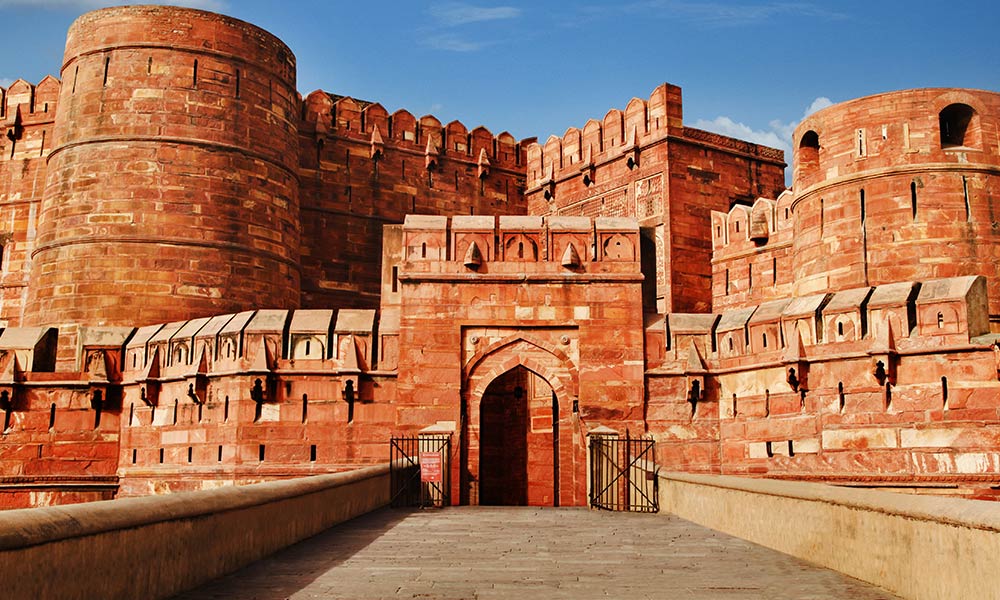
Agra Fort | #2 of 40 in the list of UNESCO World Heritage Sites in India 2021
Located on the right bank of River Yamuna, near the famous Taj Mahal, Agra Fort is yet another renowned monument built by the Mughals. It is often referred to as the Red Fort of Agra and was added to the UNESCO World Heritage list in 1983. This architectural masterpiece was constructed during the reign of Emperor Akbar in 1573 and it served as the residence of the Mughal rulers until 1638.
Also known as Red Fort and Lal Qila, this beautiful historical monument is made entirely of red sandstone. It exhibits the popular Mughal architectural style and has intricate artwork on the walls. The fort encloses many impressive structures like Khas Mahal, Jehangir Mahal, Sheesh Mahal, Diwan-E-Aam, Diwan-E-Khas, Moti Masjid, Nagina Masjid and Musamman Burj, all featuring a stunning combination of Persian and Indian art forms.
- Location: Rakabganj, Agra, Uttar Pradesh
- Best Time to Visit: October to March
- Timings: Sunrise to Sunset or 6:00 AM to 6:00 PM; 7 days a week
- Time Required: 2-3 hours
- Entry Fee (per person):
- Indians: INR 40
- Foreigners: INR 550
- Citizens of SAARC and BIMSTEC countries: INR 40
- Free for children below 15 years of age
Suggested Read: Places to visit in Agra.
3. Fatehpur Sikri, Uttar Pradesh
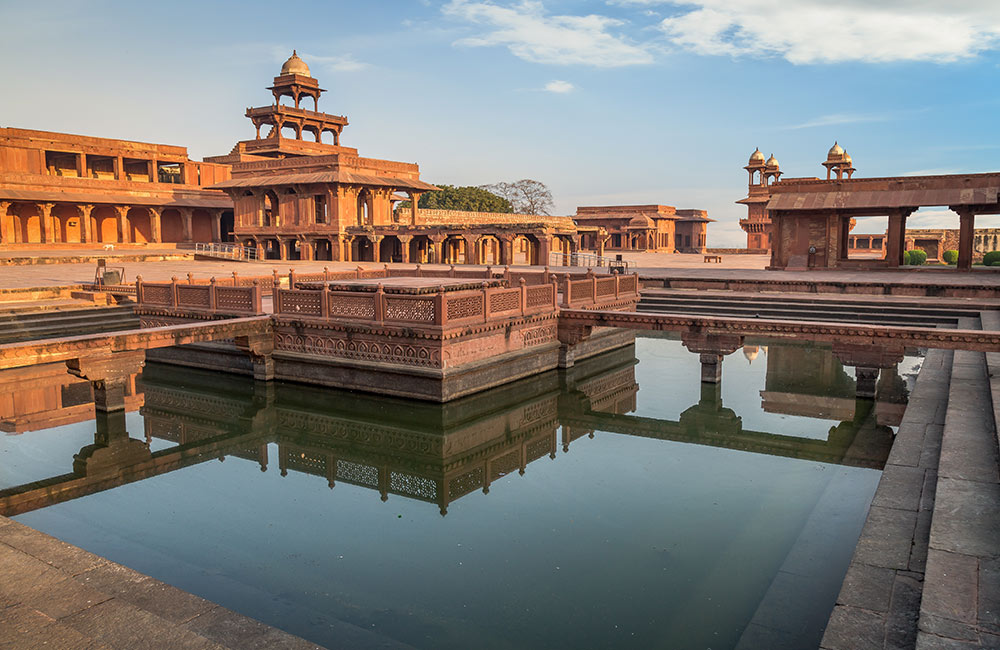
Fatehpur Sikri | #3 of 40 in the list of UNESCO World Heritage Sites in India 2021
A small yet important town in the Agra District, Fatehpur Sikri was added to the list of UNESCO World Heritage Sites in India in 1986. It was built by the Mughal Emperor Akbar in 1571 as a tribute to the great Sufi saint, Sheikh Salim Chisti. Fatehpur Sikri also served as the capital of Emperor Akbar’s empire for 15 years.
This Indo-Islamic masterpiece is one of the finest examples of Emperor Akbar’s architectural finesse. The style and design of the buildings here fascinate architecture lovers and tourists with a unique blend of Hindu and Islamic elements. The town is surrounded by an 11 km long fortification wall with numerous gateways. Within this walled premises lie some prominent structures, like the Tomb of Salim Chisti, Jama Masjid Mosque, Buland Darwaza, Palace of Jodha Bai and Panch Mahal. Fatehpur Sikri also houses many beautiful palaces, mosques and public buildings.
- Location: 37 km from Agra, Uttar Pradesh
- Best Time to Visit: October to March
- Timings: Sunrise to Sunset; 7 days a week
- Time Required: 1 day
- Entry Fee (per person):
- Indians: INR 50
- Foreigners: INR 610
- Citizens of SAARC and BIMSTEC countries: INR 50
4. Ajanta Caves, Maharashtra

Ajanta Cave | #4 of 40 in the list of UNESCO World Heritage Sites in India 2021
Dating back to somewhere between the 2nd century BCE and 650 CE, Ajanta Caves are known for their 31 rock-cut Buddhist cave monuments, paintings and sculptures. The site is under the care of the Archaeological Survey of India and was declared as one of the UNESCO sites in India in 1983. These ancient caves were built in two different phases, the first was around the 2nd century and the second one was from 400 to 650 CE. Ajanta Caves are about 101 km from Aurangabad.
These caves are known for housing many ancient monasteries and chapels. Their walls exhibit a series of paintings that throw light on the many births of Lord Buddha and his past lives. You can also see rock-cut statues of different Buddhist deities here. Cave 1, with a seated figure of Lord Buddha in dharma chakra pravartana mudra, is a major attraction here. The cave also has paintings of Bodhisattvas, Vajrapani, princesses and murals depicting Sibi, Mahajanaka, and more.
- Location: Near Jalgaon, Aurangabad district, Maharashtra
- Best Time to Visit: October to March
- Timings: 8:00 AM to 5:00 PM; closed on Mondays
- Time Required: 3-4 hours
- Entry Fee (per person):
- Indians: INR 40
- Foreigners: INR 60
- Citizens of SAARC and BIMSTEC countries: INR 40
- Free entry for children up to 15 years of age
5. Ellora Caves, Maharashtra
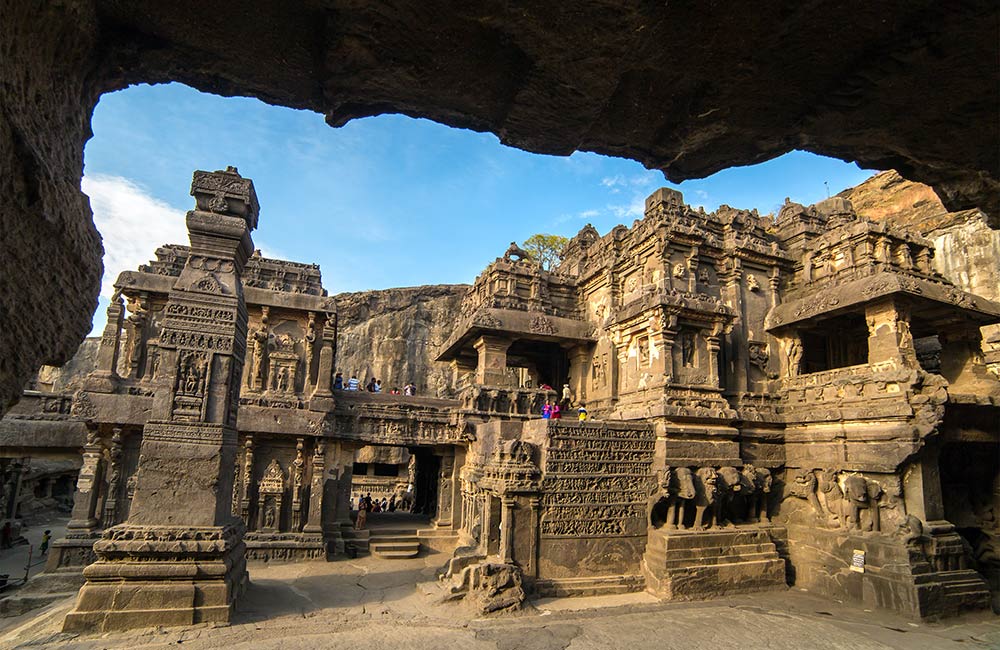
Ellora Caves | #5 of 40 in the list of UNESCO World Heritage Sites in India 2021
Sprawled over a large area, Ellora Caves and its sequence of monuments date back to the period of 600-100 CE. The large rock-cut cave complexes here are known for housing multiple Hindu, Jain and Buddhist temples and monuments. Cave 16, featuring the 32 m high Kailash Temple, which is the largest single rock excavation in the world, is a must-visit. Ellora Caves are around 32 km from Aurangabad.
The site has over 100 caves but only 34 are open to the public. These consist of 12 Buddhist caves (1-12), 17 Hindu caves (13-29) and 5 Jain caves (30-34). While the Hindu and Buddhist monuments here were constructed during the Rashtrakuta dynasty, the Jain caves were constructed during the Yadava dynasty. Apart from the unique artistic creations, the Ellora Complex also boasts the spirit of religious tolerance that prevailed in ancient India. In those days, Hindu, Jain and Buddhist devotees coexisted peacefully and created many architectural and sculptural marvels in the same location. Ellora Caves were included in the list of UNESCO World Heritage Sites in India in 1983.
- Location: Ellora Cave Road, Ellora, Maharashtra
- Best Time to Visit: October to March
- Timings: 6:00 AM to 6:00 PM; closed on Tuesdays
- Time Required: 3-4 hours
- Entry Fee (per person):
- Indians: INR 40
- Foreigners: INR 600
- Citizens of SAARC and BIMSTEC countries: INR 40
- Free entry for children up to 15 years of age
Suggested Read: Top Places to Visit near Aurangabad (within 100 km)
6. Elephanta Caves, Maharashtra
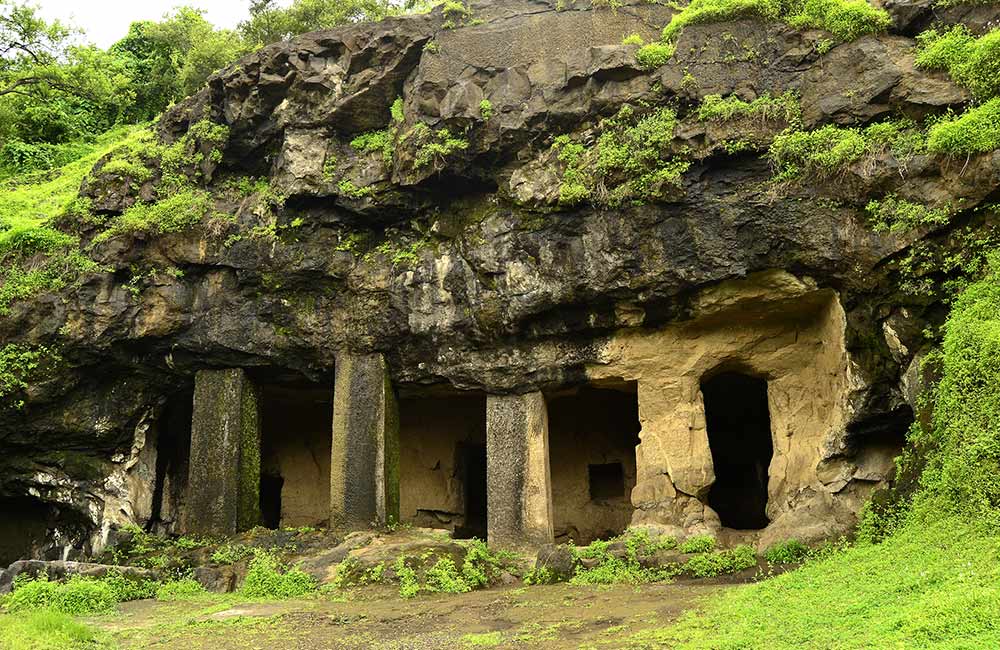
Elephanta Caves | #6 of 40 in the list of UNESCO World Heritage Sites in India 2021
Also known as Gharapurichi Leni, Elephanta Caves are a series of sculpted cave temples, mostly dedicated to Lord Shiva. They are about 25 km from Mumbai, known for their exquisite rock-cut architecture, and goes back to sometime between the 5th and 8th centuries. These ancient caves were added to the list of UNESCO World Heritage Sites in India in 1987.
There are two groups of caves here – the first one is a large group of 5 Hindu caves, while the second one consists of 2 Buddhist caves. They house many rock-cut stone sculptures, including the statue of Shiva and Parvati on Kailash, Ravana lifting Kailash Mountain, Trimurti or three forms of Lord Shiva, Ardhnareshwar or Shiva and Parvati in the same body, Shiva Linga and more. The smaller caves here showcase the Buddhistic rock-cut architecture. All in all, the caves are a treasure trove of many architectural, historical and spiritual marvels, depicting the synchronicity of Hinduism and Buddhism.
- Location: Gharapuri, Maharashtra
- Best Time to Visit: November to March
- Timings: 9:00 AM to 5:00 PM; closed on Mondays
- Time Required: 4-5 hours
- Entry Fee (per person):
- Indians: INR 40
- Foreigners: INR 250
- Citizens of SAARC and BIMSTEC countries: INR 40
- Free entry for children up to 15 years of age
Suggested Read: Forts in Maharashtra
7. Chhatrapati Shivaji Terminus, Maharashtra
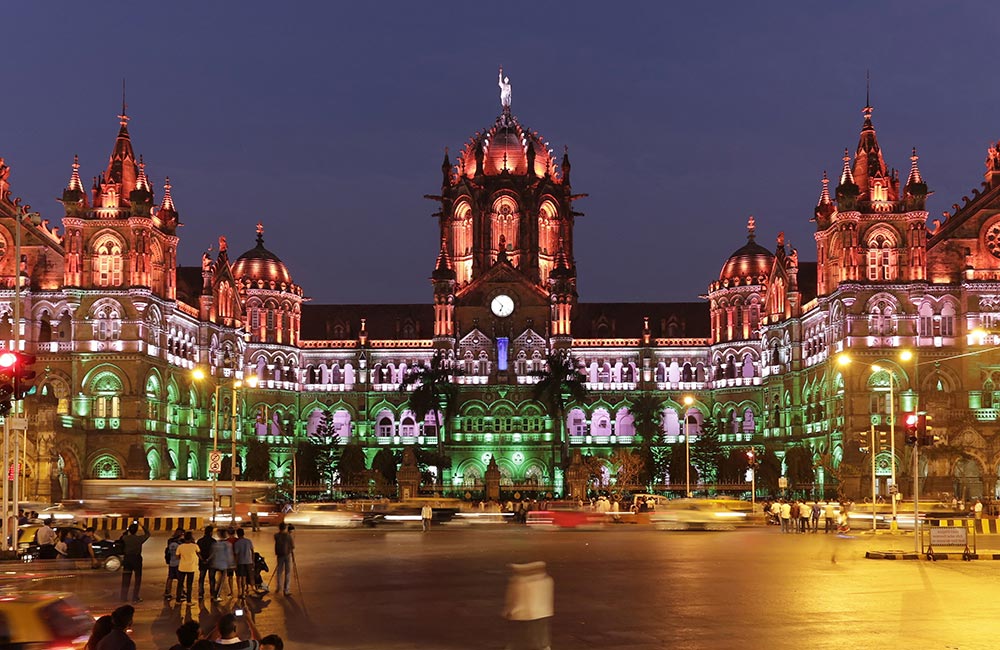
Chhatrapati Shivaji Terminus | #7 of 40 in the list of UNESCO World Heritage Sites in India 2021
Formerly known as Victoria Terminus, Chhatrapati Shivaji Terminus (CST) is a historic terminal train station in Mumbai. It was designed by a British architect named Frederick William Stevens and is one of the finest examples of Victorian Gothic architecture in India. The terminus was built from 1878-1887 and was named Victoria Terminus in honour of Queen Victoria.
Although the terminus showcases Italian and Victorian-era elements, the first glance will remind you of the Indian palace-style architecture. Hence, it can be said that Chhatrapati Shivaji Terminus is a brilliant blend of native and western art styles. The main structure is made of limestone and sandstone, while premium quality Italian marble accentuates the interiors. The terminus was added to the list of UNESCO World Heritage Sites in India in 2004. With 18 railway lines and the main headquarters, it is one of the busiest railway stations in the country.
- Location: Chhatrapati Shivaji Terminus Area, Fort, Mumbai, Maharashtra
- Best Time to Visit: October to March
- Timings: 24×7
- Time Required: Less than 1 hour
- Entry Fee: Free
Suggested Read: Places to visit in Maharashtra
8. Victorian and Art Deco Ensembles of Mumbai, Maharashtra
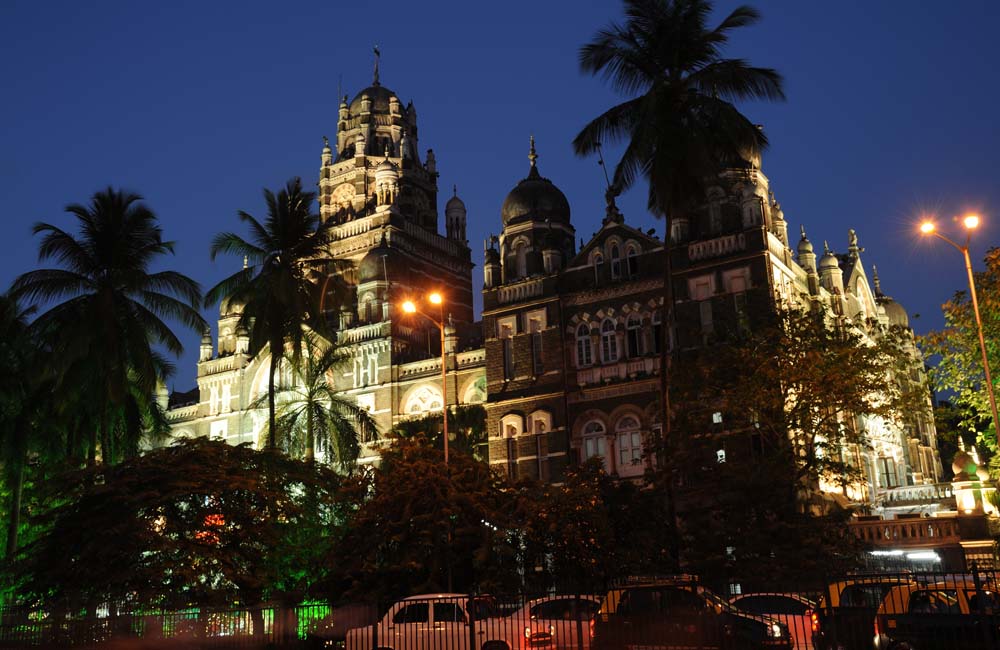
Victorian and Art Deco Ensembles of Mumbai | #8 of 40 in the list of UNESCO World Heritage Sites in India 2021
Victorian and Art Deco Ensembles of Mumbai comprises the 19th century Victorian neo-Gothic public buildings and the 20th century Art Deco buildings located in the Fort Area of the city. These buildings were included in the list of UNESCO World Heritage Sites in India in 2018. They are set around a large recreational ground called the Oval Maidan.
The east side of the Oval Maidan features Victorian Gothic public buildings, like The Fort Campus of the University of Mumbai, Bombay High Court, David Sassoon Library, Elphinstone College and the Old Secretariat Building. The western side is dotted with Art Deco buildings, like Eros Cinema and privately-owned residential buildings. The different styles and creativity of the two segments add a distinctive charm to the cityscape.
- Location: Mumbai, Maharashtra
- Best Time to Visit: November to March
- Timings: 24×7
- Time Required: 1-2 days
- Entry Fee: Not applicable
9. Churches and Convents of Goa
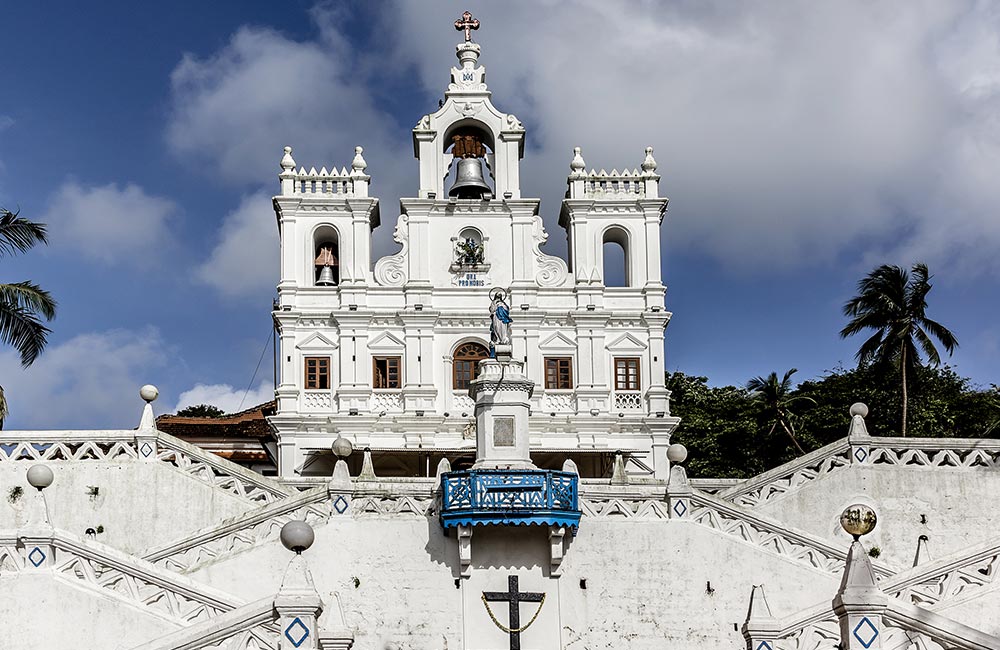
Churches and Convents of Goa | #9 of 40 in the list of UNESCO World Heritage Sites in India 2021
Added to the list of UNESCO World Heritage Sites in India in 1986, the Churches and Convents of Goa include some significant monuments. These include Basilica do Bom Jesus, Saint Catherine’s Chapel, Igreja de Sao Francisco de Assis, Church and Convent of Saint Francis of Assisi, Church of Saint Augustine and Church of Our Lady of the Rosary.
The Portuguese set their foot in Goa in the 15th and 16th centuries and ruled the union territory for over 450 years. They also introduced Christianity in Goa and other states in India. Hence, there are many churches and convents in Goa, all showcasing exquisite architecture, paintings and sculptures. These beautiful monuments were built by the Portuguese colonial rulers. Considering their stunning construction and the distinctive charm they add to Old Goa, these churches and convents were declared UNESCO World Heritage Sites.
- Location: Old Goa
- Best Time to Visit: November to February
- Timings: 24×7
- Time Required: 1-2 days
- Entry Fee: Free
Suggested Read: Top 15 Places to visit in Goa
10. Khajuraho Group of Monuments, Madhya Pradesh
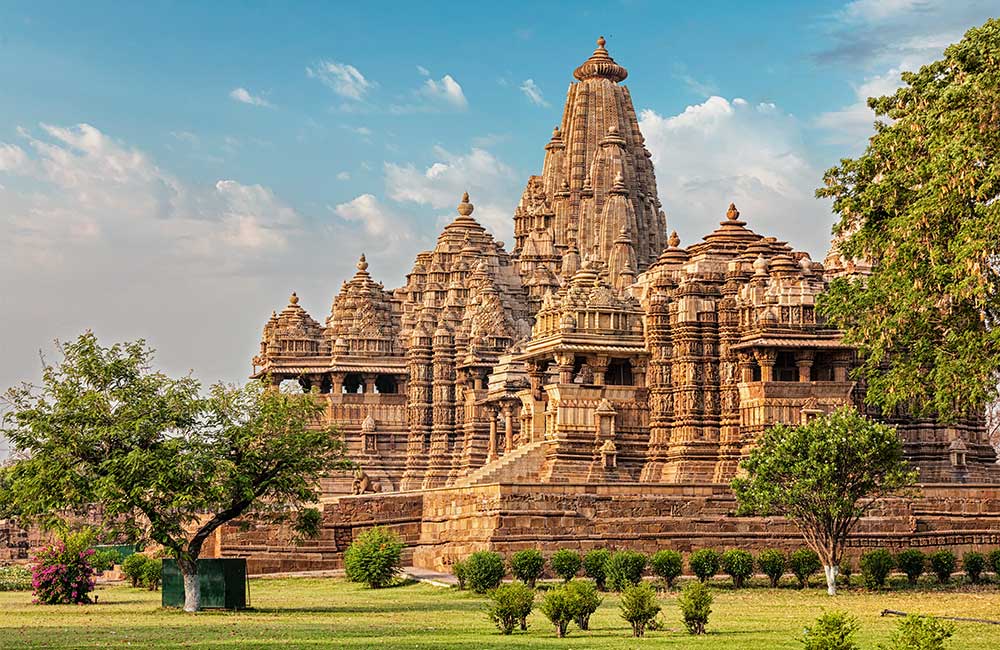
Khajuraho Group of Monuments | #10 of 40 in the list of UNESCO World Heritage Sites in India 2021
Boasting inimitable artistic creations, the Khajuraho Group of Monuments made it to the list of UNESCO World Heritage Sites in India in 1986. This heritage site houses a group of Hindu and Jain temples exhibiting the Nagara style of architecture. These ornate temples were constructed by Chandela rulers between 950 CE and 1050 CE. While there were around 85 temples spread over an area of 20 square kilometres in the 12th century, only about 20 temples could survive the ravages of time.
The Khajuraho Group of Monuments is particularly known for their erotic figurines and sculptures celebrating dance, music, and sensuality. Also, the erotic sculptures are only 10% of the total sculptures present here and portrayed extremely aesthetically. Khajuraho temples are made of superior quality sandstone and the detailed carvings of the surviving sculptures steal the show. The site also has museums showcasing hundreds of sculptures and masterpieces from the bygone era.
- Location: Chhatarpur, Madhya Pradesh
- Best Time to Visit: October to March
- Timings: Sunrise to Sunset; 7 days a week
- Time Required: 4-5 hours
- Entry Fee (per person):
- Indians: INR 40
- Foreigners: INR 600
- Citizens of SAARC and BIMSTEC countries: INR 40
- Free entry for children below 15 years of age
- Extra charges for museums and light and sound show
Suggested Read: Places to visit in Madhya Pradesh
11. Buddhist Monuments at Sanchi, Madhya Pradesh
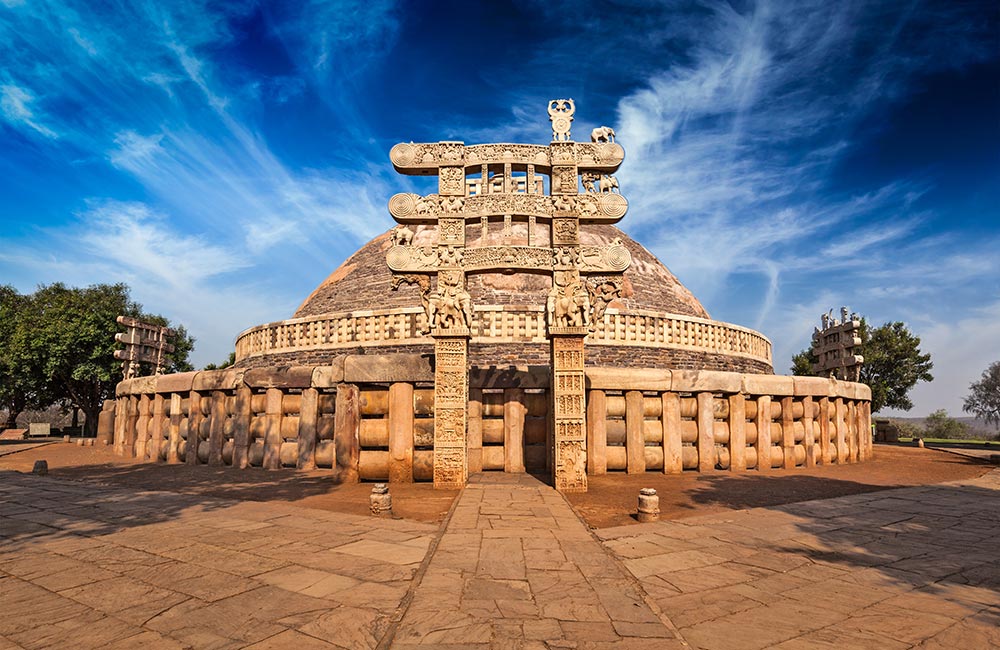
Buddhist Monuments at Sanchi | #11 of 40 in the list of UNESCO World Heritage Sites in India 2021
The Buddhist Monuments at Sanchi are a group of monuments dating back to 200 BC and 100 BC. Perched on a hilltop overlooking the plains, the site of Sanchi includes Buddhist monuments in the form of palaces, temples, monasteries and monolithic pillars. These monuments were active religious sites for the Buddhists until the 12th century AD.
The main monument here, the Great Sanchi Stupa, which dates to the 3rd century BCE, is one of the oldest stone structures in India. It has a unique Buddhist-style architecture with detailed rock carvings on the gateways. The dome, which is 36 m in diameter and 16 m high, is the focal point of the Stupa. Considering the unique cultural importance of the Buddhist Monuments at Sanchi, the site was added to the list of UNESCO World Heritage Sites in India in 1989.
- Location: Sanchi town, Raisen district, Madhya Pradesh
- Best Time to Visit: November to March
- Timings: 6:30 AM to 6:30 PM; 7 days a week
- Time Required: 3-4 hours
- Entry Fee (per person):
- Indians: INR 40
- Foreigners: INR 600
- Citizens of SAARC and BIMSTEC countries: INR 40
- Free entry for children up to 15 years of age
Suggested Read: Gwalior Fort (Another Top Attraction in MADHYA PRADESH)
12. Rock Shelters of Bhimbetka, Madhya Pradesh
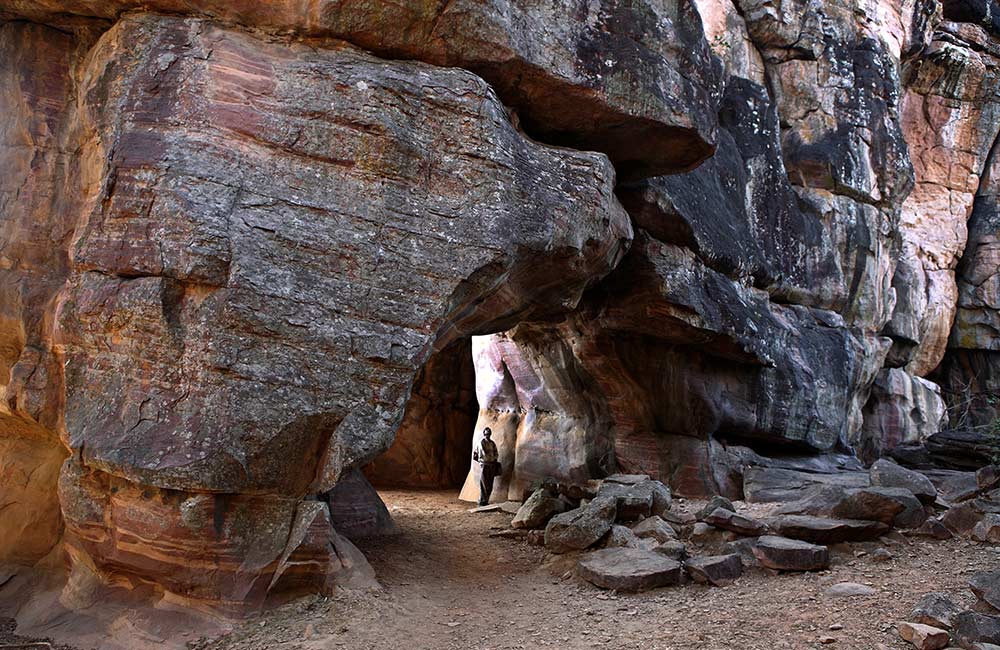
Bhimbetka Rock Shelters | #12 of 40 in the list of UNESCO World Heritage Sites in India 2021
Located in the foothills of the Vindhyachal Mountains, Rock Shelters of Bhimbetka were added to the list of UNESCO World Heritage Sites in India in 2003. According to the Archaeological Survey of India, this is the place from where the South Asian Stone Age began. The rock shelters were reportedly occupied by humans until the 2nd century BCE. Although these shelters were discovered by a team of archaeologists in 1957, their size and true significance were unearthed only in the 1970s.
The site features five clusters of rock shelters with Mesolithic era (from 10000 BC to 8000 BC) carvings and paintings on them. These paintings give you an idea about the life and activities of humans during that age, such as hunting and communal dancing. Zoo Rock and Natraj Paintings are popular attractions here. Out of the 750 rock shelters discovered, 243 come under the Bhimbetka group and only 12-15 are open to visitors.
- Location: Raisen District, Madhya Pradesh (45 km from Bhopal)
- Best Time to Visit: October to April
- Timings: 7:00 AM to 6:00 PM; 7 days a week
- Time Required: 2 hours
- Entry Fee (per person):
- Indians: INR 30
- Foreigners: INR 500
- Citizens of SAARC and BIMSTEC countries: INR 30
- Free entry for children up to 15 years of age
13. Sun Temple, Odisha
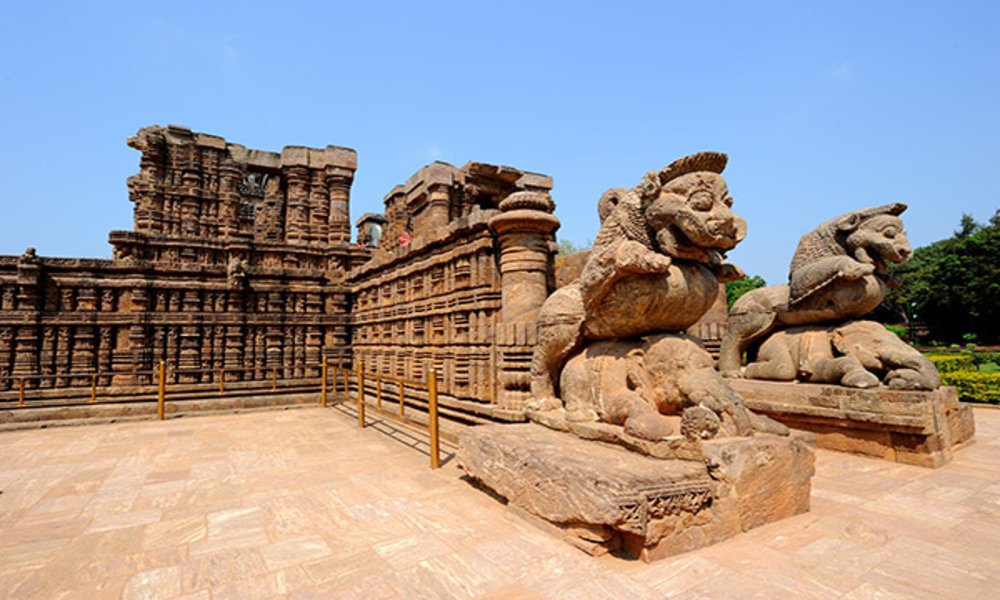
Sun Temple | #13 of 40 in the list of UNESCO World Heritage Sites in India 2021
Also known as Black Pagoda, Konark Sun Temple is one of the finest examples of Kalinga architecture. It is situated on the east coast of the Bay of Bengal and is only 35 km from Puri. This 13th-century temple dedicated to Surya or Sun God is known for its unique structure. It is built in the form of a massive stone chariot for Surya, led by seven horses. The structure of the temple also includes 24 wheels of chariot and huge walls and pillars.
The temple houses three deities of the Sun God on three different sides. The deities are placed in such a manner that direct sun rays fall on them in the morning, afternoon and evening. The temple complex also has an archaeological museum. This incredible masterpiece was declared a UNESCO World Heritage Site in 1984.
- Location: Konark, Puri District, Odisha
- Best Time to Visit: October to March
- Timings: 6:00 AM to 8:00 PM; 7 days a week
- Time Required: 2-3 hours
- Entry Fee (per person):
- Indians: INR 40
- Foreigners: INR 600
- Citizens of SAARC and BIMSTEC countries: INR 40
- Free entry for children up to 15 years of age
Suggested Read: Places to visit in Odisha
14. Humayun’s Tomb, New Delhi
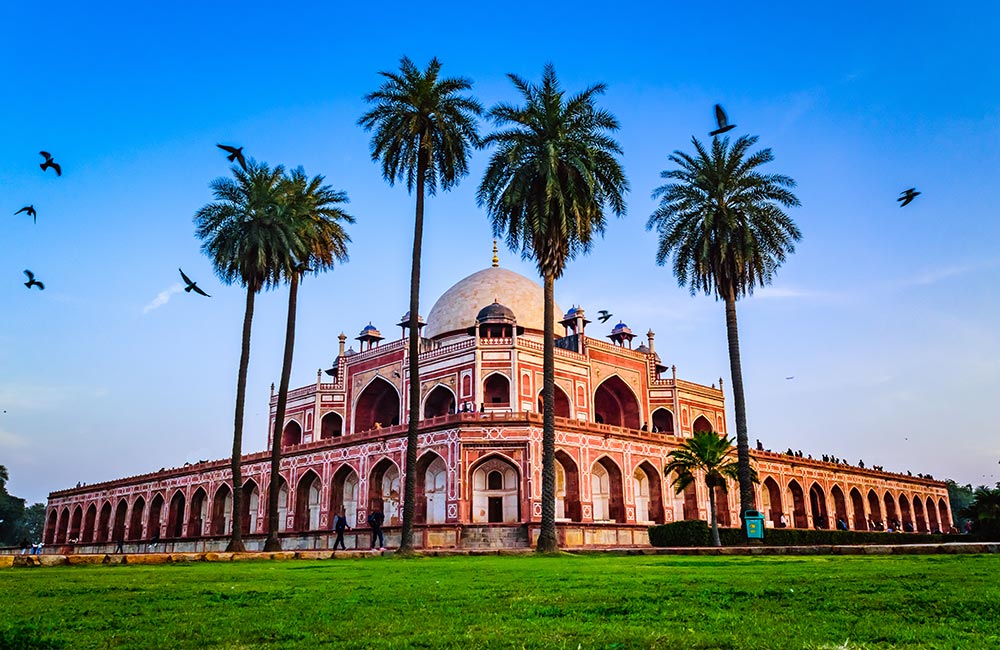
Humayun’s Tomb | #14 of 40 in the list of UNESCO World Heritage Sites in India 2021
Built in the 16th century, Humayun’s Tomb is counted among the best-preserved Mughal monuments in the country. It was built by Emperor Humayun’s wife, Empress Bega Begum, in memory of her husband. This popular mausoleum, which is the first garden-tomb in the sub-continent, was added to the list of UNESCO World Heritage Sites in India in 1993.
Apart from the main tomb of Emperor Humayun, the complex houses graves of Empress Bega Begum, Hamida Begum, Dara Shikoh (Emperor Shah Jahan’s son) and many other Mughals. The site has a total of about 150 tombs of different members of the royal family. The eye-catching Persian architecture, the four Persian-style gardens and the two-storeyed mausoleum on a huge platform are the main attractions here.
- Location: Mathura Road, Opposite Hazrat Nizamuddin Aulia Dargah, New Delhi
- Best Time to Visit: October to March
- Timings: 6:00 AM to 6:00 PM; 7 days a week
- Time Required: 1-2 hours
- Entry Fee (per person):
- Indians: INR 30
- Foreigners: INR 500
- Citizens of SAARC and BIMSTEC countries: INR 30
- Free entry for children up to 15 years of age
Suggested Read: Places to visit in Delhi
15. Qutub Minar and its Monuments, New Delhi
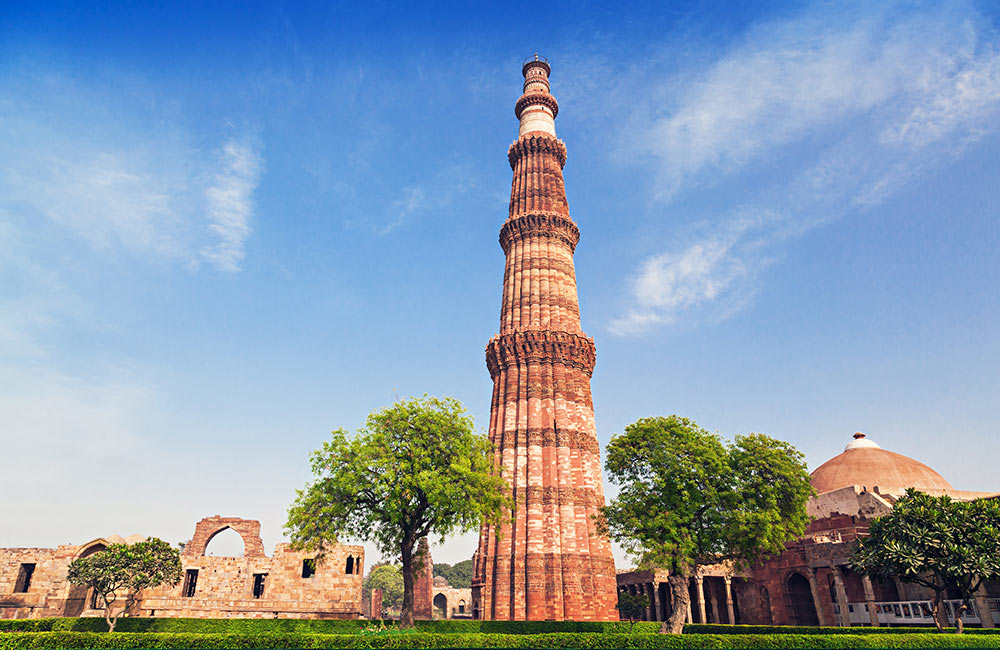
Qutub Minar | #15 of 40 in the list of UNESCO World Heritage Sites in India 2021
Constructed at the beginning of the 13th century, Qutub Minar and its monuments were included in the list of UNESCO World Heritage Sites in India in 1993. The complex is located in South Delhi, with Qutub Minar serving as the main attraction. Boasting a height of 73 m, Qutub Minar is the tallest brick minaret in the world. This 800-year-old Minar is a fine example of Islamic architecture and one of the oldest structures in the world as well. Its red sandstone and marble construction with beautiful designs and carvings are one of a kind.
Apart from the Qutub Minar, the complex houses Quwwat ul-Islam Mosque, Alai Darwaza Gate, Iron Pillar and Alai Minar. The tombs of Iltutmish, Imam Zamin and Ala-ud-din Khilji are also a part of the complex.
- Location: Seth Sarai, Mehrauli, New Delhi
- Best Time to Visit: October to March
- Timings: 7:00 AM to 5:00 PM; 7 days a week (Qutub Minar)
- Time Required: 2-3 hours
- Entry Fee per person (Qutub Minar):
- Indians: INR 30
- Foreigners: INR 500
- Citizens of SAARC and BIMSTEC countries: INR 30
- Free entry for children up to 15 years of age
Suggested Read: Things to do in Delhi
16. Red Fort Complex, Delhi
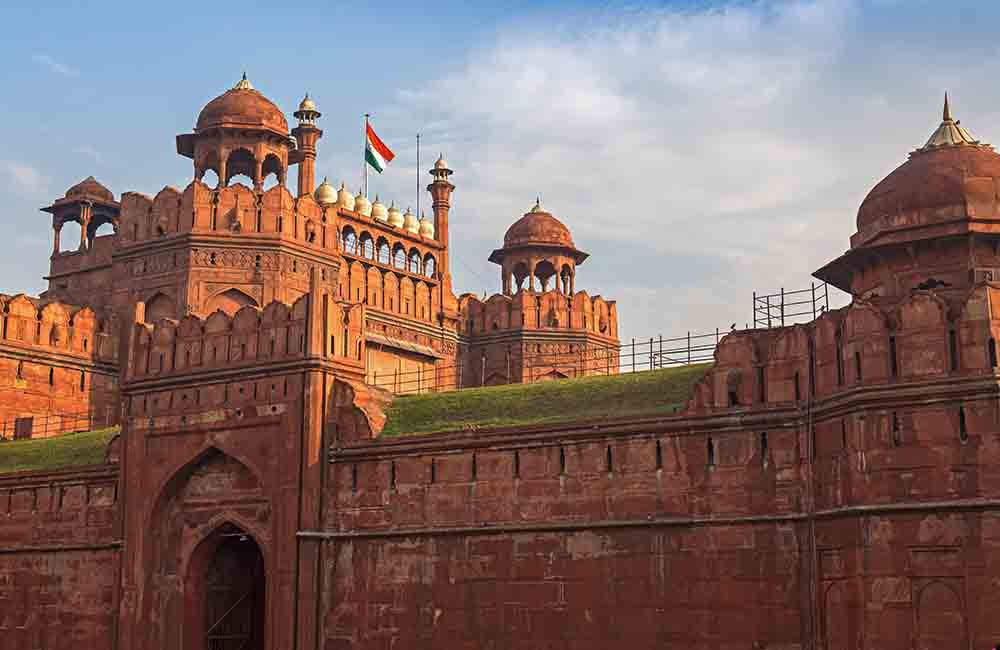
Red Fort | #16 of 40 in the list of UNESCO World Heritage Sites in India 2021
Also known as Lal Qila, Red Fort is a palace fort built during the reign of Shahjahan. The fort derives its name from its massive and impregnable red sandstone walls. This major historical building once served as the main residence of the Mughal emperors after Shahjahan shifted his capital from Agra to Delhi. Persian, Indian and Timurid styles of architecture accentuate the beauty of the monument and make it one of the best cultural sites in India.
The Red Fort complex houses many small buildings, such as Diwan-i-Aam, Diwan-i-Khas, Delhi Gate, Lahori Gate and private pavilions. This politically significant monument was declared a UNESCO World Heritage Site in 2007. Red Fort is the place where Independence Day celebrations take place every year. The monument is now protected by the Archaeological Survey of India.
- Location: Netaji Subhash Marg, Lal Qila, Chandni Chowk, New Delhi
- Best Time to Visit: October to March
- Timings: Sunrise to Sunset (closed on Mondays)
- Time Required: 2-3 hours
- Entry Fee per person:
- Indians: INR 90
- Foreigners: INR 950
- Citizens of SAARC and BIMSTEC countries: INR 90
- Light and sound show: 6 PM onwards in Hindi and English
Weekdays:
-
- Adults: INR 60
- Children: INR 20
Weekends:
-
- Adults: INR 80
- Children: INR 30
17. Capitol Complex, Chandigarh
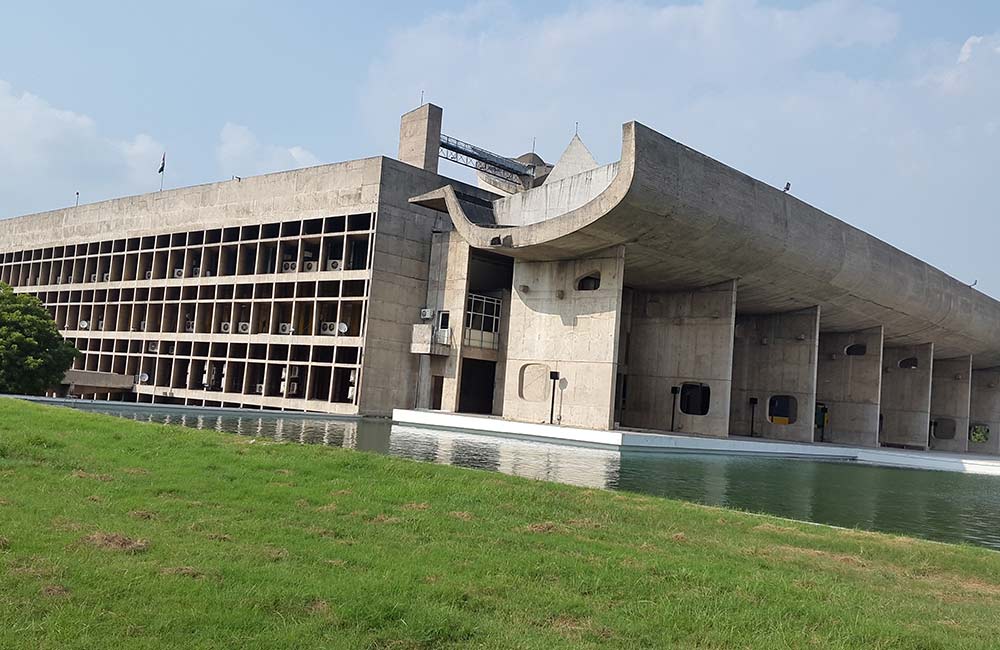
Capitol Complex | #17 of 40 in the list of UNESCO World Heritage Sites in India 2021
Designed by a master architect named Le Corbusier, the Capitol Complex is one of the best landmarks in Chandigarh. It is popularly known as the Architectural Work of Le Corbusier and was added to the list of UNESCO World Heritage Sites in India in 2016.
The entire complex is spread over an area of 100 acres and is known for housing some of the best works of the architect in the form of three concrete buildings. These include the Palace of Assembly or Legislative Assembly, Secretariat Building and the High Court. Open Hand Monument, Martyrs Memorial, Geometric Hill, Rock Garden and Tower of Shadows are the other major attractions here.
- Location: Sector 1, Chandigarh
- Best Time to Visit: October to March
- Timings: 9 AM to 5 PM; 7 days a week
- Time Required: 2-3 hours
- Entry Fee: Free entry
Suggested Read: Places to Visit in Chandigarh
18. Jantar Mantar, Jaipur, Rajasthan
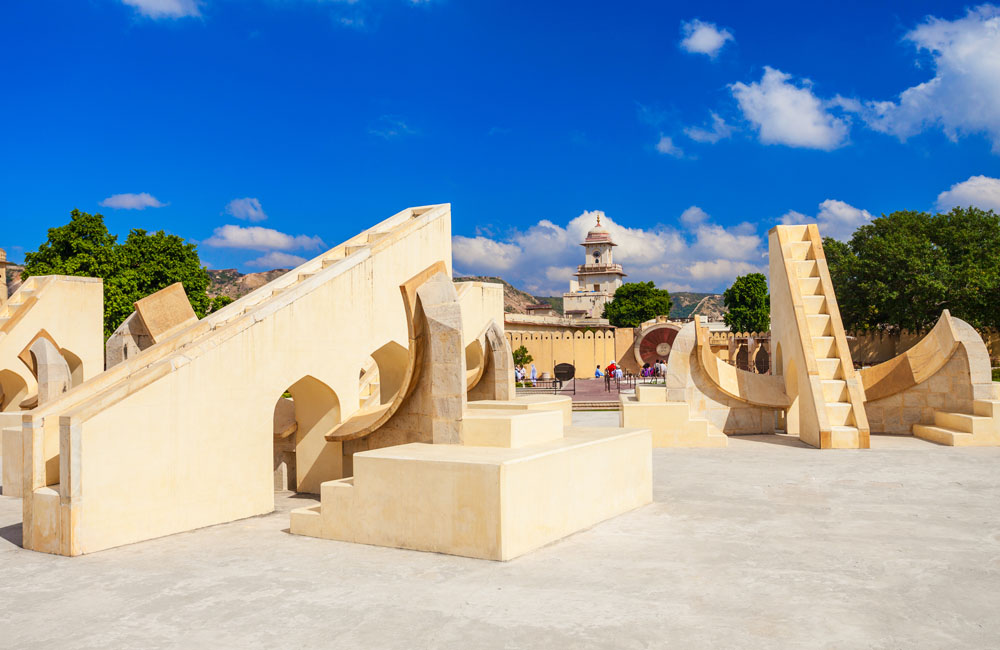
Jantar Mantar jaipur | #18 of 40 in the list of UNESCO World Heritage Sites in India 2021
Built by Maharaja Sawai Raj Singh II in the early 18th century, Jaipur’s Jantar Mantar is famous for being the largest stone astronomical observatory in the world. A fascinating thing about this observatory is that it was far ahead of its time. It boasts smart construction and the instruments here are placed in such a way that observers can see celestial objects with their naked eyes.
Jantar Mantar has a total of 19 manmade astronomical instruments. You can also find the world’s largest sundial – the Samrat Yantra, here. The observatory is also known for housing instruments operating in the three classical celestial coordinate systems – the equatorial system, the horizon-zenith local system and the ecliptic system. Considering its rich scientific value and cultural heritage, Jantar Mantar was included in the list of UNESCO World Heritage Sites in India in 2010.
- Location: Gangori Bazaar, J.D.A. Market, Jaipur, Rajasthan
- Best Time to Visit: September to March
- Timings: 9 AM to 4:30 PM; 7 days a week
- Time Required: 1-2 hours
- Entry Fee (per person):
- Indians: INR 50
- Foreigners: INR 200
- Citizens of SAARC and BIMSTEC countries: INR 50
- Indian Students: INR 15
- Foreign Students: INR 100
Suggested Read: Places to visit in Jaipur
19. Jaipur City, Rajasthan
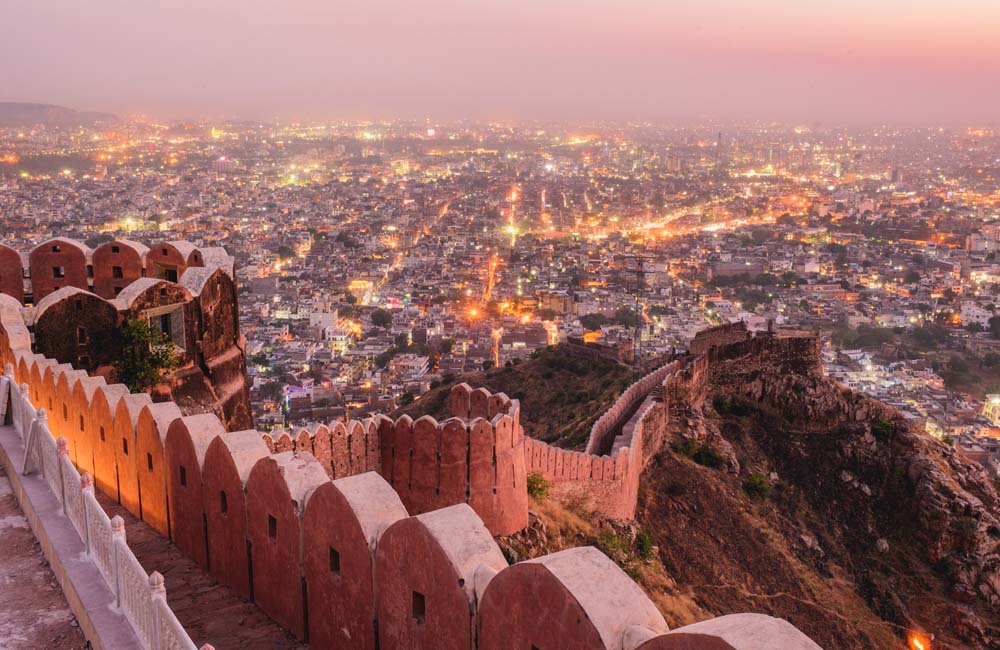
Jaipur City | #19 of 40 in the list of UNESCO World Heritage Sites in India 2021
A new addition to the list of UNESCO World Heritage Sites in India, the Pink City Jaipur was declared a cultural heritage site in 2019. This beautiful city is steeped in royal heritage, magnificent architecture and rich culture. It is peppered with some of the most amazing palaces, forts and havelis that will take you back in time. The structures showcase an impressive blend of Rajput, Mughal and Deccan architectural styles, with European influences. Some popular ones are City Palace, Jantar Mantar, Hawa Mahal, Amber Fort, Jaigarh Fort and Nahargarh Fort.
The Pink City is famous for vibrant bazaars like Johri Bazaar, Bapu Bazaar and Badi Chaupar. Selling beautiful Rajasthani jewellery, handicrafts, fabrics and many more products, these local bazaars are a paradise for shopaholics. Jaipur is also home to Akshardham Temple, Birla Mandir, ISKCON Temple and other religious places.
- Location: Rajasthan
- Best Time to Visit: October to March
- Timings: 24×7
- Time Required: 2-3 days
- Entry Fee: Not applicable
Suggested Read: Things to do in Jaipur
20. Hill Forts of Rajasthan
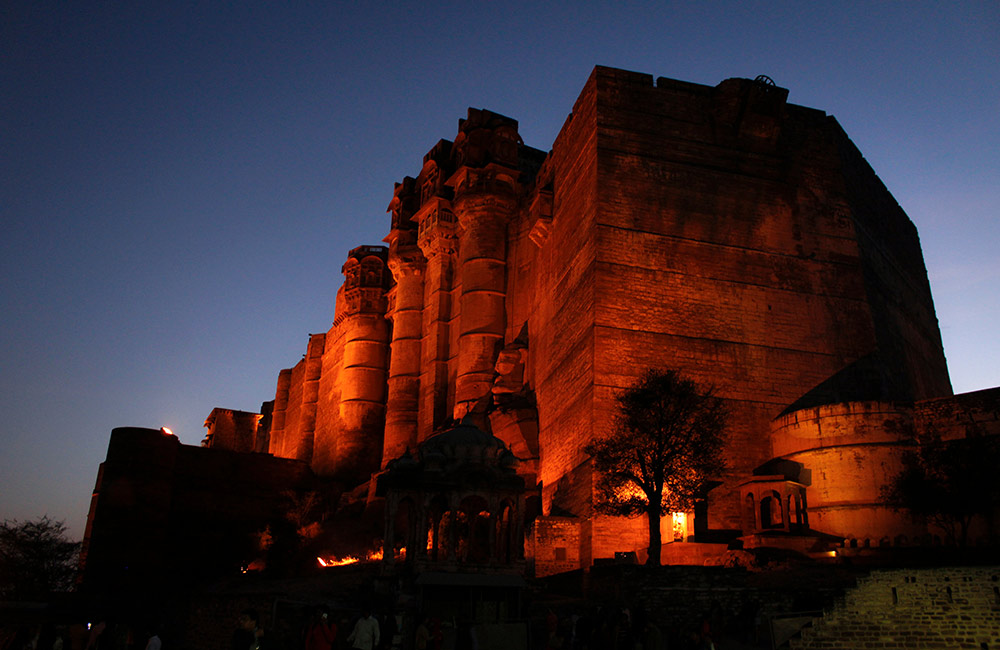
Nahargarh Fort | #20 of 40 in the list of UNESCO World Heritage Sites in India 2021
Located on the rugged Aravalli Mountains, the Hill Forts of Rajasthan were declared UNESCO World Heritage Sites in India in 2013. These are a series of 6 majestic forts named Chittor Fort, Amer Fort, Kumbhalgarh Fort, Gagron Fort, Ranthambore Fort and Jaisalmer Fort. These majestic structures were built by several Rajput kings between the 5th and 18th centuries CE.
Showcasing a type of Rajput military hill architecture with huge fortifications, each fort was built using advanced construction techniques. The natural terrains and contours were also utilized for better defence. Since these forts were built keeping the safety aspect in mind, they enclose vast areas as well as villages within their walled compounds. Some temples, palaces, markets and trading centres still exist here. The grand Hill Forts of Rajasthan showcase the power of Rajputana rulers, their royal history, as well as the unique Rajput defence architecture.
- Location: Rajasthan
21. Group of Monuments at Hampi, Karnataka
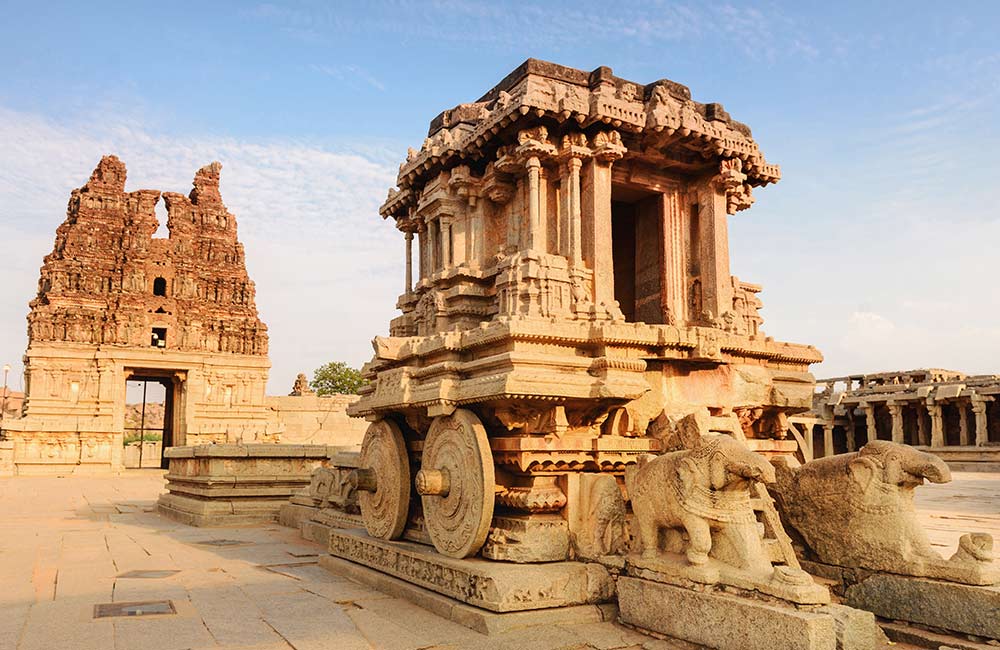
Group of Monuments at Hampi | #21 of 40 in the list of UNESCO World Heritage Sites in India 2021
Located on the southern bank of the Tungabhadra River in Karnataka, the city of Hampi takes you back to those times when it was the kingdom of Vijayanagar. Hampi was the capital city of the Vijayanagar Empire in the 14th century and the magnificent remnants of the bygone era attract history buffs and tourists from far and wide.
The Group of Monuments at Hampi comprise over 1600 surviving structures, including temples, shrines, forts, gateways, halls, museums, water structures and more. Some popular ones are Virupaksha Temple, Vittala Temple, Hazara Rama Temple, Palace of Vira Harihara, Hampi Bazaar, Queen’s Bath, Lotus Mahal and archaeological museum. Hampi was declared a UNESCO World Heritage Site India in 1986.
- Location: Vijayanagar district, Karnataka
- Best Time to Visit: October to February
- Time Required: 2 days
Suggested Read: Places to visit in karnataka
22. Group of Monuments at Pattadakal, Karnataka
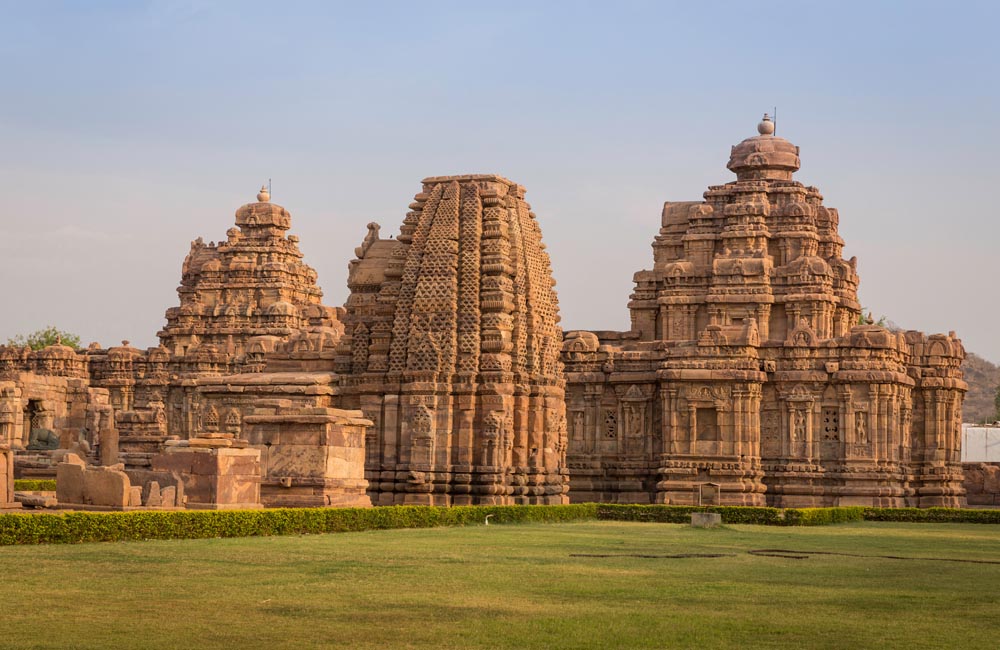
Group of Monuments at Pattadakal | #22 of 40 in the list of UNESCO World Heritage Sites in India 2021
Included in the list of UNESCO World Heritage Sites in India in 1987, the Group of Monuments in Pattadakal uphold the richness and intricacy of Chalukyan architecture. These monuments date to the 7thand 8th centuries and showcase an impressive blend of Northern and Southern India architectural designs – Nagara, Rekha, Dravida, Prasada and Vimana styles. Pattadakal holds great importance in the history of South India as this is the place where all the Chalukya kings were coronated.
Pattadakal has a series of nine Hindu temples and a Jain sanctuary, all exhibiting brilliant architecture. While the Hindu temples are mostly dedicated to Lord Shiva, the Jain temple is dedicated to a single Jina. The Group of Monuments in Pattadakal are Virupaksha Temple, Mallikarjuna Temple, Galaganatha Temple, Sangameshwara Temple, Kashi Vishwanatha Temple, Papanatha Temple, Jambulingeshwara Temple, Kadasiddheshwara Temple, Chandrashekhara Temple, and Jain Narayana Temple.
- Location: Bagalkot district, Karnataka
- Best Time to Visit: October to March
- Time Required: 2-3 days
23. Kakatiya Rudreshwara (Ramappa) Temple, Telangana
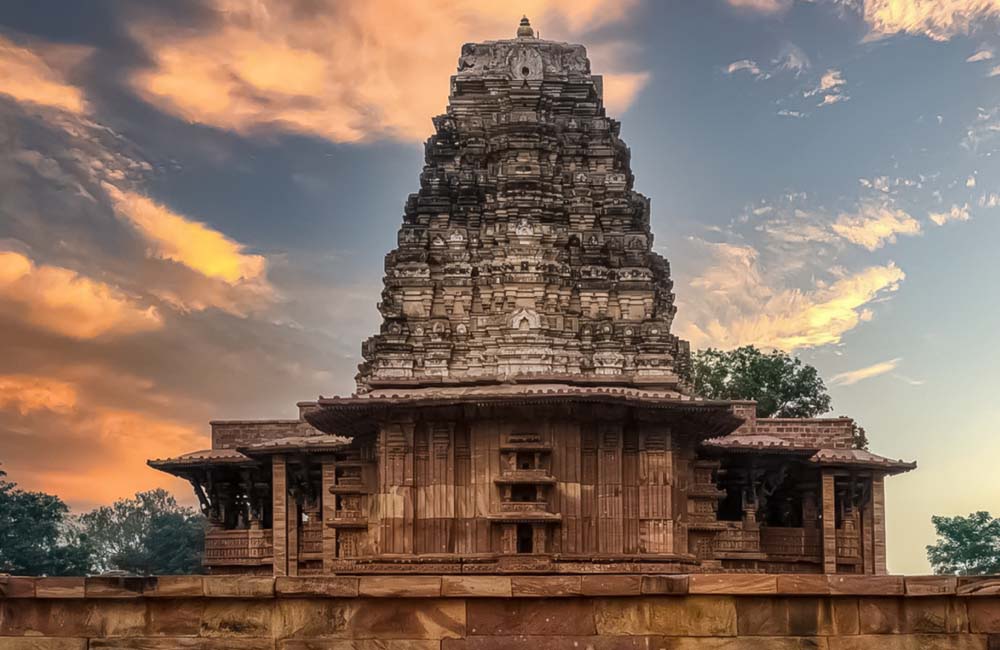
Ramappa Temple Telangana | #23 of 40 in the list of UNESCO World Heritage Sites in India 2021
One of the latest additions to the list, Kakatiya Rudreshwara Temple was declared a UNESCO World Heritage Site in India in 2021. This beautiful sandstone temple is also known as Ramappa Temple. Dating to 1213 AD, the temple was constructed during the reign of Recharla Rudra, who was a general of the Kakatiya king, Ganapati Deva. It is dedicated to Lord Shiva and a 9-feet Shivalinga is the main deity here.
Standing on a 6-feet high platform, the temple showcases the Vesara style of architecture and stunning craftsmanship. While the foundation is built using the “sandbox technique”, the pyramidal Vimana is made of lightweight porous bricks that can float on water. Besides these, the intricate carvings on the pillars, walls and ceilings of the temple emphasize its beauty and attest to the unmatched skill of the Kakatiyan sculptors.
- Location: Ramappa, Mulugu, Telangana
- Best Time to Visit: September to March
- Timings: 6:00 AM to 6:00 PM; 7 days a week
- Time Required: 1-2 hours
- Entry Fee: Free entry
Suggested Read: Places to visit in Telangana
24. Group of Monuments at Mahabalipuram, Tamil Nadu
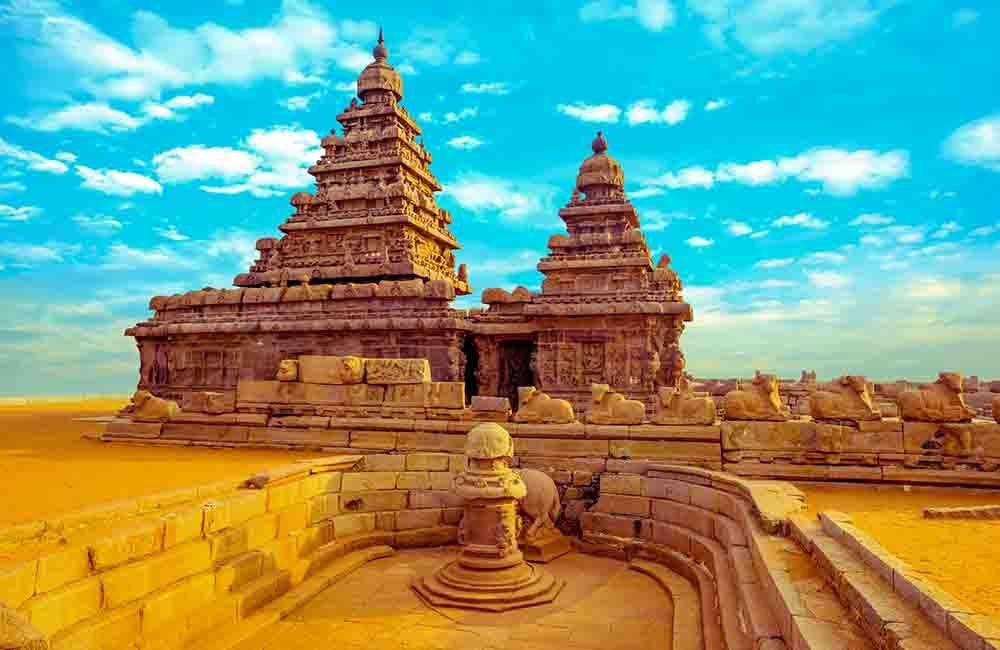
Group of Monuments Mahabalipuram | #24 of 40 in the list of UNESCO World Heritage Sites in India 2021
Located on the Coromandel Coast of Bay of Bengal, the Group of Monuments at Mahabalipuram were built in the 7th and 8th centuries by Pallava rulers. The temple town has around 40 ancient Hindu temples and monuments, including the Descent of the Ganges – one of the largest open-air rock-cut reliefs in the world. Carved out of rocks around the Coromandel Coast and showcasing magnificent illustrations of the ancient civilization, the monuments are nothing less than architectural grandeurs.
Considering their architectural brilliance and cultural importance, the monuments at Mahabalipuram were added to the list of UNESCO World Heritage Sites in India in 1984. They are categorised into 5 groups – 10 Rathas or chariot-shaped temples, 10 Mandapas or cave temples, 2 Rock reliefs, 3 Structural temples, and excavations. The Five Rathas, Shore Temple, Mahishamardini Cave, Varaha Cave, Panchapandava Mandapa, and Descent of the Ganges are most popular among tourists.
- Location: Fisherman Colony, Mahabalipuram, Tamil Nadu (58 km from Chennai)
- Best Time to Visit: November to March
- Timings: 6:00 AM to 6:00 PM; 7 days a week
- Time Required: 3-4 hours
- Entry Fee for all Monuments (per person):
- Indians: INR 40
- Foreigners: INR 600
- Citizens of SAARC and BIMSTEC countries: INR 40
- Free for children below 15 years of age
Suggested Read: Hill Stations in South India
25. Great Living Chola Temples, Tamil Nadu
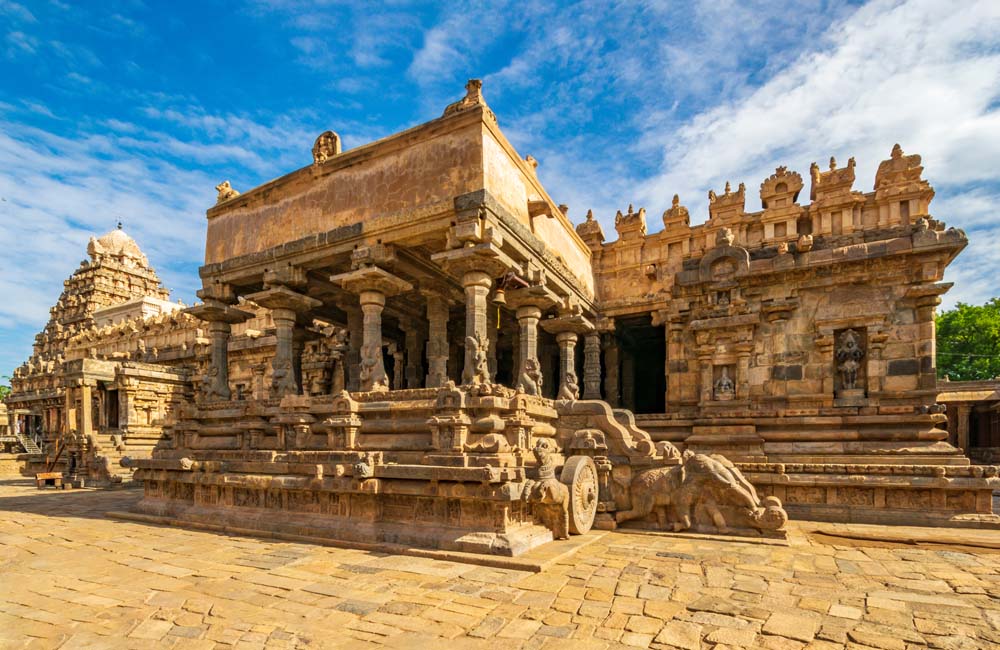
Great Living Chola Temples | #25 of 40 in the list of UNESCO World Heritage Sites in India 2021
Built by the kings of the Chola dynasty between the 11th and 12th centuries, Chola Temples in the southern part of India are known for their outstanding art and architecture. The site which includes three temples was inscribed on the UNESCO World Heritage Sites in India list in 1987.
The three Great Living Chola Temples are Brihadisvara Temple in Thanjavur, Brihadisvara Temple in Gangaikonda Cholapuram, and Airavatesvara Temple in Darasuram. While all three are dedicated to Lord Shiva, their architecture makes them different from one another.
Built between 1003 AD and 1010 AD by Rajaraja Chola I, the Thanjavur temple is known for housing one of the largest Shivalingas in India. Also, the vimanam tower above the temple is one of the tallest in South India.
The temple in Gangaikonda Cholapuram was completed by Rajendra Chola I in 1035 AD. Apart from the main shrine and linga, the temple houses many small shrines and monuments. The eye-catching bronze sculptures, a statue of Nandi and artwork on the walls set this temple apart from the rest.
Built by Rajaraja II, Airavatesvara Temple in Darasuram was completed in 1166 AD. The long steps made of granite stones, intricately carved pillars, royal courtyard and other structures here are a testimony to the fine craftsmanship of the Chola dynasty.
These Great Living Chola Temples still observe the festivities and rituals that were held thousands of years ago, thereby keeping the ancient culture and heritage of the Tamilians alive.
- Location: Tamil Nadu
- Brihadeeswara Temple, Thanjavur: Membalam Road, Balaganapathy Nagar
- Brihadisvara Temple, Gangaikonda Cholapuram: Jayankondam
- Airavatesvara Temple, Darasuram: Gurunathan Pillai Road, Kumbakonam
- Best Time to Visit: November to March
- Timings:
- Thanjavur temple: 6:00 AM to 12:30 PM, 4:00 PM to 8:30 PM; Monday-Sunday
- Gangaikonda Cholapuram temple: 6:00 AM to 12:00 PM, 4:00 PM to 8:00 PM; Monday-Sunday
- Darasuram temple: 8:00 AM to 12:00 PM, 4:00 PM to 8:00 PM; Monday-Sunday
- Time Required: 1-2 days
- Entry Fee: Free entry
26. Mountain Railways of India
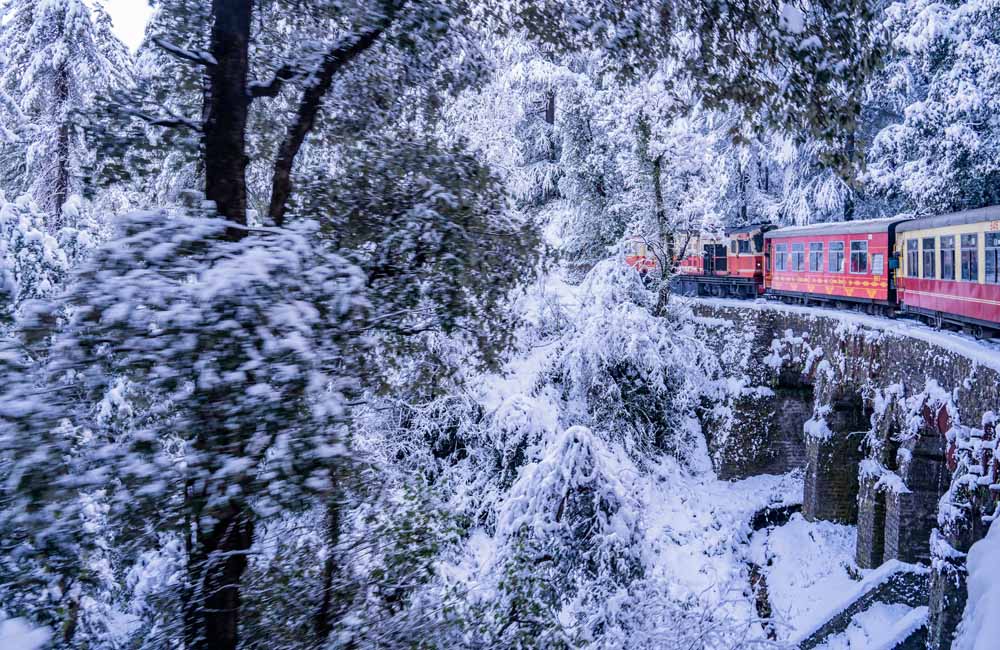
Mountain Railways of India | #26 of 40 in the list of UNESCO World Heritage Sites in India 2021
The Mountain Railways of India – Darjeeling Himalayan Railway, Nilgiri Mountain Railway and Kalka-Shimla Railway, were added to the list of UNESCO World Heritage Sites in 1999, 2005 and 2008, respectively. As per UNESCO, the Mountain Railways in India are smart and indigenous engineering solutions to the problem of establishing rail connectively across the tough and rugged mountainous regions in the country.
While the Darjeeling Himalayan Railway and Kalka-Shimla Railway are situated in North India, in the rugged and hilly regions of the Himalayas, Nilgiri Mountain Railway is in the Western Ghats of South India. All three railway lines pass through scenic terrains offering stunning views.
Suggested Read: Must take toy train ride (Kalka to Shimla)
27. Archaeological Site of Nalanda Mahavihara in Nalanda, Bihar
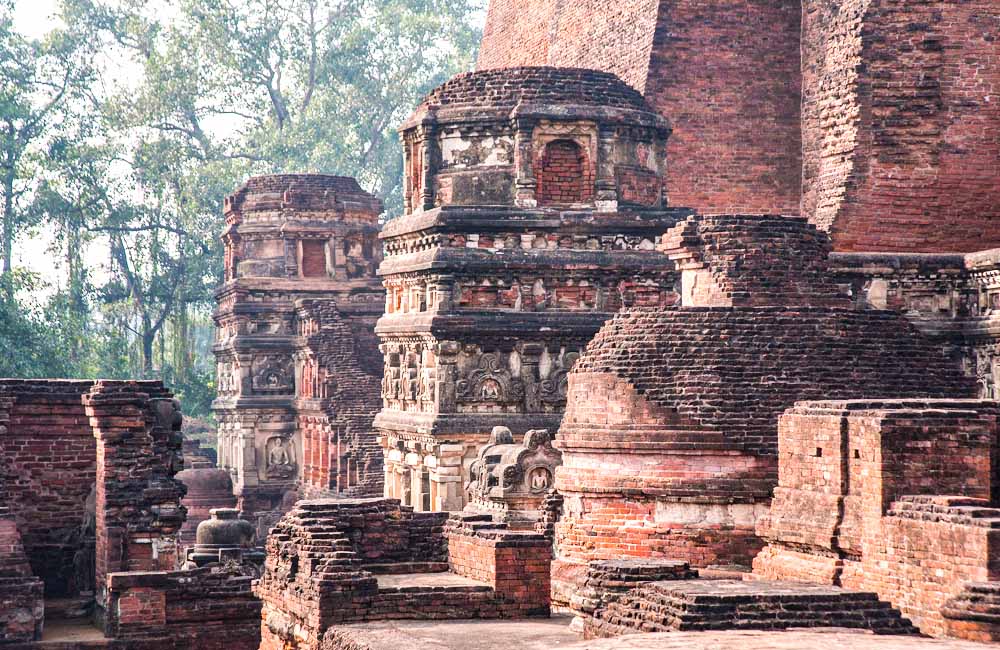
Archaeological Site of Nalanda Mahavihara in Nalanda | #27 of 40 in the list of UNESCO World Heritage Sites in India 2021
Located around 83 km from Patna, Nalanda Mahavihara was included in the list of UNESCO World Heritage Sites in India in 2016. The site is famed for housing the archaeological remains of a Buddhist monastery-cum-scholastic establishment that existed from the 3rd century BCE to the 13th century CE. Here, you will come across stupas, viharas (residential and educational buildings), shrines as well as important creations in stone, stucco and metal.
Famous for being the most ancient university in the Indian subcontinent, Nalanda Mahavihara imparted knowledge continuously for over 800 years. The place reportedly attracted students and scholars from Tibet, Korea, China and Central Asia as well. The archaeological remains at Nalanda Mahavihara also testify to the evolution of Buddhism as a religion in India.
- Location: Nalanda district, Bihar
- Best Time to Visit: October to March
- Timings: 9:00 AM to 5:00 PM; closed on Fridays
- Time Required: 1 hour
- Entry Fee (per person):
- Indians: INR 15
- Foreigners: INR 200
- Citizens of SAARC and BIMSTEC countries: INR 15
- Nalanda Museum Fee: INR 15
- Free for children up to 15 years of age
28. Mahabodhi Temple Complex of Bodh Gaya, Bihar
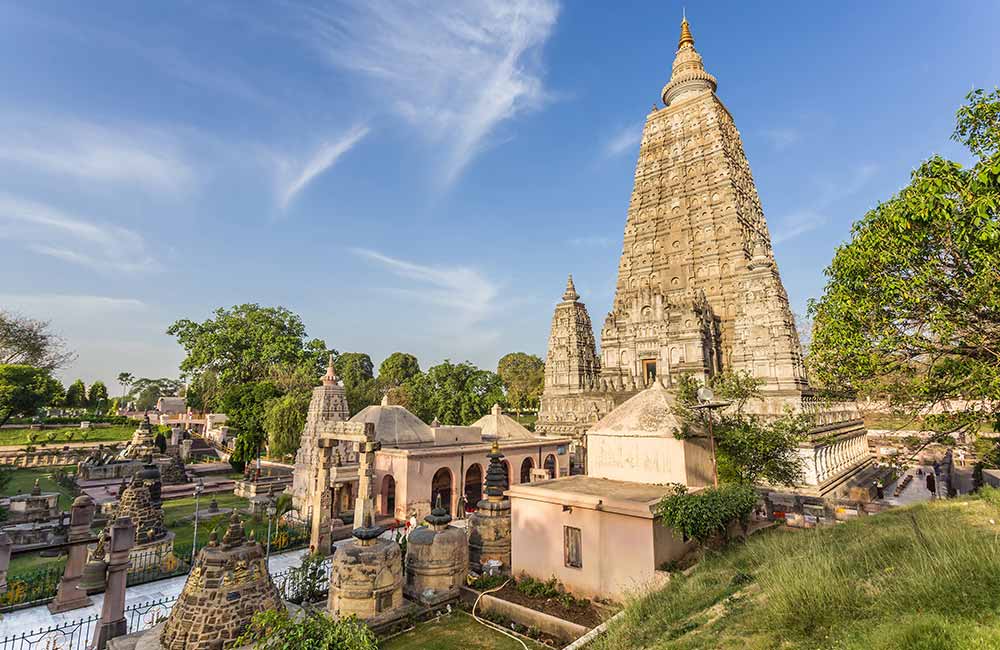
Mahabodhi Temple | #28 of 40 in the list of UNESCO World Heritage Sites in India 2021
Regarded as one of the holiest sites for Buddhists, the Mahabodhi Temple Complex of Bodh Gaya is where Gautam Buddha attained enlightenment. It is believed that Siddhartha Gautama sat in deep meditation under the holy Bodhi tree here and attained enlightenment. The temple complex is 111 km from Patna and is the first temple that Emperor Ashoka built in the 3rd century. The one visible now dates to sometime between the 5th and 7th centuries.
Mahabodhi Temple is also a wonderful example of the earliest brick structures in the country. Spread over an area of 5 hectares, the temple complex comprises the 50 m tall Vajrasana or Mahabodhi Temple, the sacred Bodhi Tree, six more sacred sites of Buddha’s enlightenment, a Lotus Pond and numerous ancient votive stupas. Considering the cultural and archaeological significance of the place, the temple complex was declared a UNESCO World Heritage Site in 2002.
- Location: Bodh Gaya, Bihar
- Best Time to Visit: October to March
- Timings: 5:00 AM to 9:00 PM; 7 days a week
- Time Required: 2-3 hours
- Entry Fee: Free entry
29. Champaner-Pavagadh Archaeological Park, Gujarat
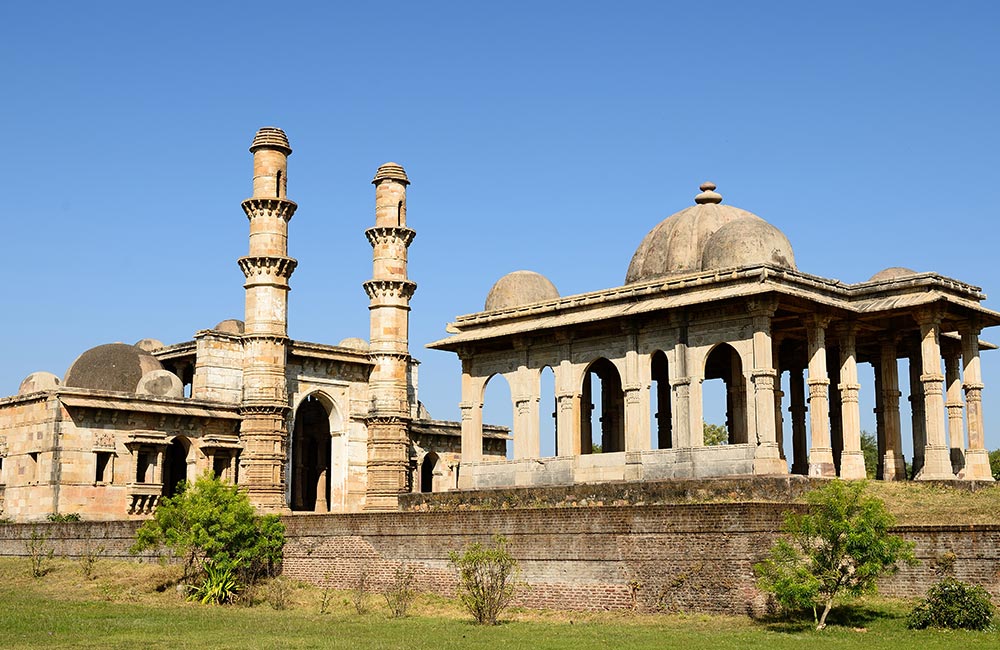
Champaner-Pavagadh Archaeological Park | #29 of 40 in the list of UNESCO World Heritage Sites in India 2021
Situated in the Panchmahal district in Gujarat, Champaner-Pavagadh Archaeological Park is a heritage site housing many architectural wonders. This park is dotted with forts that start from the hills of Pavagarh and extend to the city of Champaner. From a hill fortress, chalcolithic sites, palaces and gateways to temples, mosques, tombs, residential complexes, stepwells and agricultural structures, the park’s landscape includes them all.
The Hindu shrine Kalika Mata Temple on the top of Pavagadh Hill (800 m high) attracts devotees from across the country. A significant aspect of the park is that the transition from Hindu to Muslim architecture and culture during the 15th and 16th centuries is evident here. Thanks to its historical and mythological significance, this archaeological park was included in the list of UNESCO World Heritage Sites in India in 2004. The site is also famed for being the only complete and untouched Islamic pre-Mughal city.
- Location: Panchmahal district, Gujarat
- Best Time to Visit: October to February
- Timings: 6:00 AM to 6:00 PM; 7 days a week
- Time Required: 4-5 hours
- Entry Fee (per person):
- Indians: INR 35
- Foreigners: INR 550
- Citizens of SAARC and BIMSTEC countries: INR 35
30. Rani-ka-Vav, Patan, Gujarat
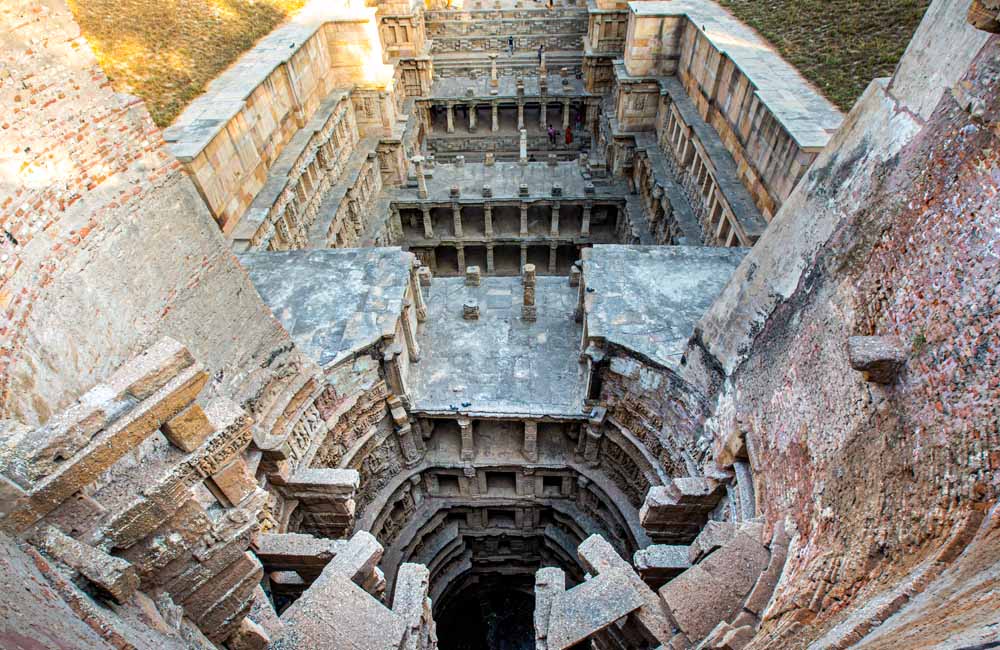
Rani ka Vav | #30 of 40 in the list of UNESCO World Heritage Sites in India 2021
Known for its size and sculpture, Rani ka Vav or “Queen’s Stepwell” is a unique kind of water storage system in a small town called Patan. It is located on the banks of River Saraswati and is more than 64 m long, 20 m wide and 27 m deep. The stepwell was built in the 11th century by Rani Udayamati and its water reportedly had medicinal properties. The site was completely buried under silt and was rediscovered in the 1940s. Rani-ka-Vav was declared a UNESCO World Heritage Site in 2014.
The stepwell boasts Maru-Gurjara architectural style and is famous for being the most magnificent of its kind in Gujarat. It is designed as an inverted temple with seven levels of stairs, each decorated with sculptural panels. It houses more than 500 main sculptures of Lord Vishnu in his different avatars and over 1000 minor ones. The intricately carved statues of yoginis and apsaras here with “solah-shringar” are some of the finest examples of the architectural brilliance of the Chalukya Dynasty.
- Location: Mohan Nagar Society, Patan, Gujarat
- Best Time to Visit: October to March
- Timings: 8:00 AM to 6:00 PM; 7 days a week
- Time Required: 1-2 hours
- Entry Fee (per person):
- Indians: INR 25
- Foreigners: INR 300
- Citizens of SAARC and BIMSTEC countries: INR 25
- Free for children up to 15 years of age
31. Historic City of Ahmedabad, Gujarat
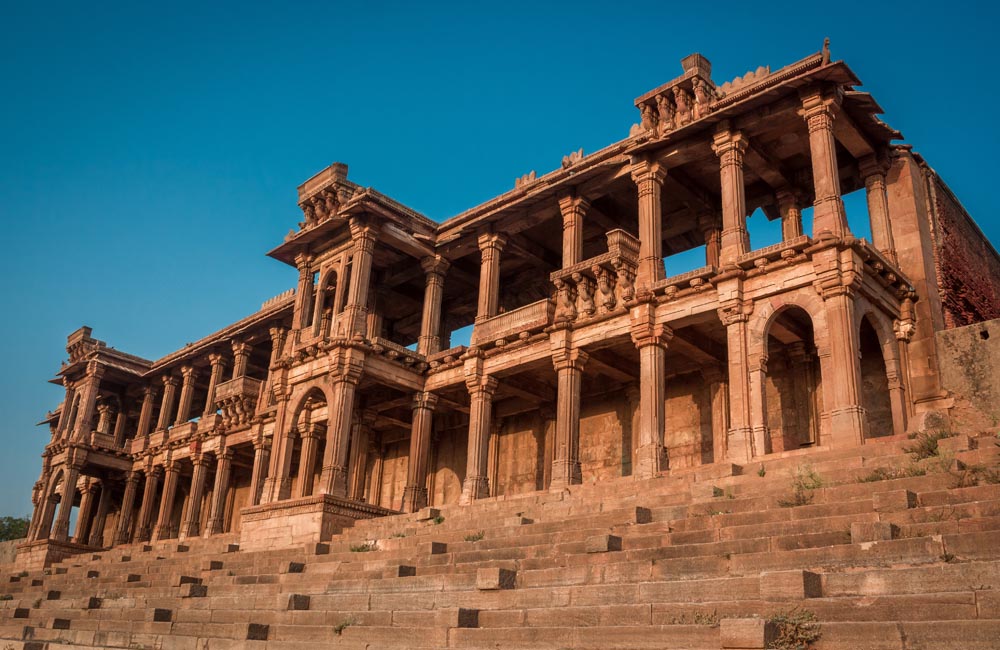
Historic City of Ahmedabad | #31 of 40 in the list of UNESCO World Heritage Sites in India 2021
Boasting a rich and unique heritage, the historic city of Ahmedabad was added to the list of UNESCO World Heritage Sites in India in 2017. The capital city of Gujarat is the first city in India to get the heritage tag. UNESCO praised the city’s sultanate architecture, particularly Bhadra Citadel, various mosques and tombs, Hindu and Jain temples and the walls and gates of the fort city. Ahmedabad was founded by Ahmed Shah I of the Gujarat Sultane in 1411 and is located on the banks of the Sabarmati River.
Popularly known as the walled city, Ahmedabad is home to many Indo-Islamic monuments constructed between the 15th and 17th centuries. However, the charm of the city lies in the traditional housing clusters (Pols) on the gated streets (Puras) with bird feeders, old public wells and places of worship. As a religiously diverse city, the rich culture of Ahmedabad can be attributed to the Hindu, Muslim and Jain communities and influencers who have lived here for centuries.
- Location: Gujarat
- Best Time to Visit: November to February
- Time Required: 1-2 days
Suggested Read: places to visit in Ahmedabad
32. Dholavira: A Harappan City
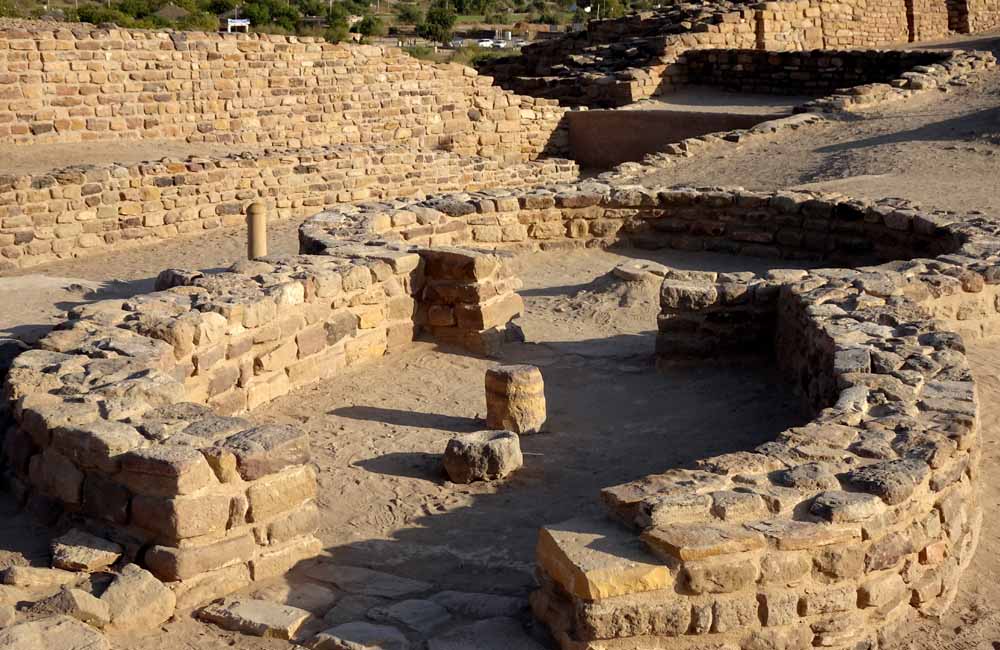
Dholavira: A Harappan City | #32 of 40 in the list of UNESCO World Heritage Sites in India 2021
Declared a UNESCO World Heritage Site in India in 2021, the Harappan city of Dholavira in the Rann of Kutch is an amazing and well-preserved urban settlement in South Asia. The site, which was discovered by archaeologist Jagat Pati Joshi in 1968, contains ruins of the ancient Indus Valley Civilization. Dholavira was reportedly occupied from 3000-1500 BCE and is the fifth largest of the eight Harappan sites.
Spread over an area of 22 hectares, the city of Dholavira was designed with gateways, street systems, defence works, wells, huge open spaces, and more. Different types of artefacts made of stone, copper, ivory, terracotta, and shell were found on the site. As per UNESCO, “the site is set apart by its unique characteristics, such as its water management system, multi-layered defensive mechanisms, extensive use of stone in construction and special burial structures”. As a popular heritage site, Dholavira offers great insight into the ancient customs, societies and communities.
- Location: Khadirbet, Kutch District, Gujarat
- Best Time to Visit: October to March
- Timings: 6:00 AM to 6:00 PM; 7 days a week
- Time Required: 2-3 hours
- Entry Fee (per person): INR 5
Natural
33. Kaziranga National Park, Assam
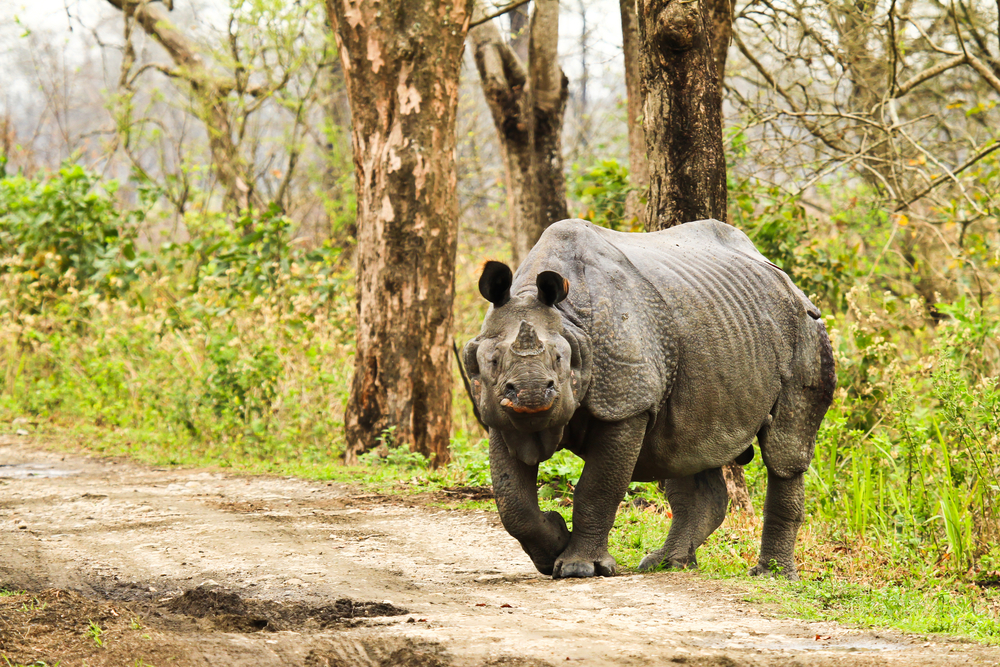
Kaziranga National Park | #33 of 40 in the list of UNESCO World Heritage Sites in India 2021
Lying on the flood plains of River Brahmaputra, Kaziranga National Park is one of the most popular natural areas in India. The place became a part of the list of UNESCO World Heritage Sites in 1985. Boasting abundant flora and fauna, the national park is a treat for nature lovers. The dense forests, grasslands, lakes, and streams add to the beauty of the park and make it one of a kind.
Kaziranga National Park is spread over an area of 430 sq. km. and is known for housing the largest number of one-horned rhinos on earth. It also holds many tigers, elephants, swamp deer, wild water buffaloes, sloth bears, common otters, Gangetic dolphins and many more mammals. The national park is considered an important bird area by the Birdlife International Society as it is home to a wide range of inhabitants and migratory birds.
- Location: Golaghat and Nagaon districts, Assam
- Best Time to Visit: November to April
- Timings: 24×7
- Time Required: 1-2 days
- Entry Fee (per person):
- Indians: INR 100
- Foreigners: INR 650
- Citizens of SAARC and BIMSTEC countries: INR 100
- Extra charges for elephant safari and jeep safari
34. Manas Wildlife Sanctuary, Assam
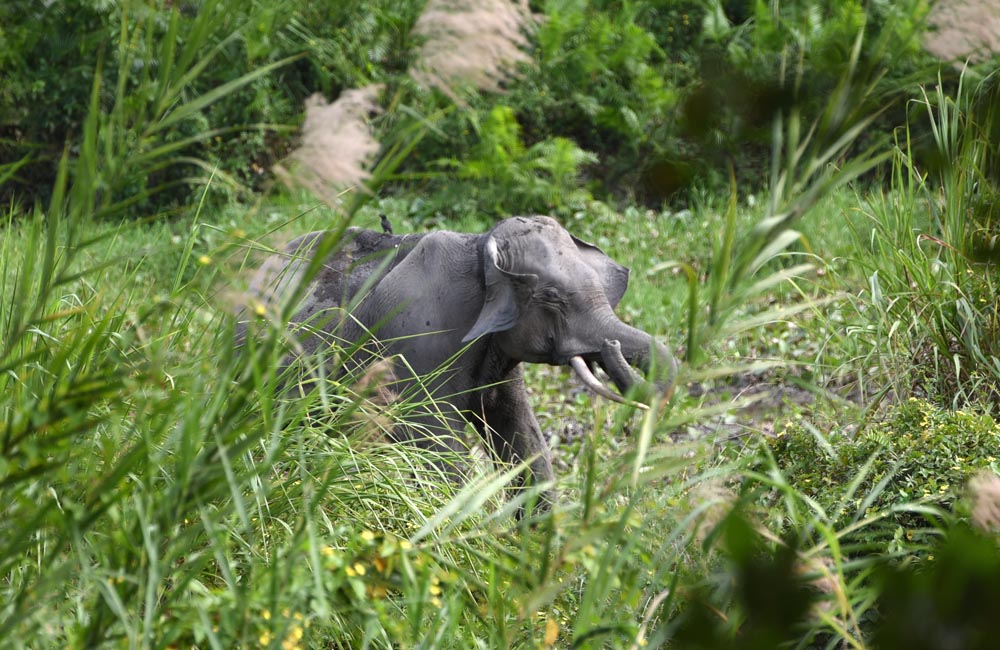
Manas Wildlife Sanctuary | #34 of 40 in the list of UNESCO World Heritage Sites in India 2021
Located in the foothills of the Himalayas, on the plains of Manas River, Manas Wildlife Sanctuary was added to the list of UNESCO World Heritage Sites in India in 1985. The sanctuary, with abundant flora and fauna, is also a biosphere reserve, Project Tiger Reserve and a Project Elephant Reserve. It boasts a unique and comfortable natural environment that plays host to a range of rare and endemic wildlife such as Golden Langur, Pygmy Hog, Assam Roofed Turtle, Red Panda and Hispid Hare.
Manas Wildlife Sanctuary is counted among the best-maintained national parks in India. Its scenic location and natural landscape with tropical evergreen forests and lush green hills add to the beauty of the sanctuary and make it a popular attraction among nature and wildlife lovers. The sanctuary is famous for its population of tigers, wild water buffaloes, Indian one-horned rhinoceros, barking deer, leopards, Assam roofed turtle, and more.
- Location: Manas Road, Barangabari Gyati Village, Baksa District, Gobardhana, Assam
- Best Time to Visit: November to April
- Timings: 6:00 AM to 3:00 PM; 7 days a week
- Time Required: 1 day
- Entry Fee (per person):
- Indians: INR 50 (half day), INR 200 (full day)
- Foreigners: INR 500 (half day), INR 2000 (full day)
- Extra charges for gypsy safari, photography and videography
35. Keoladeo National Park, Rajasthan
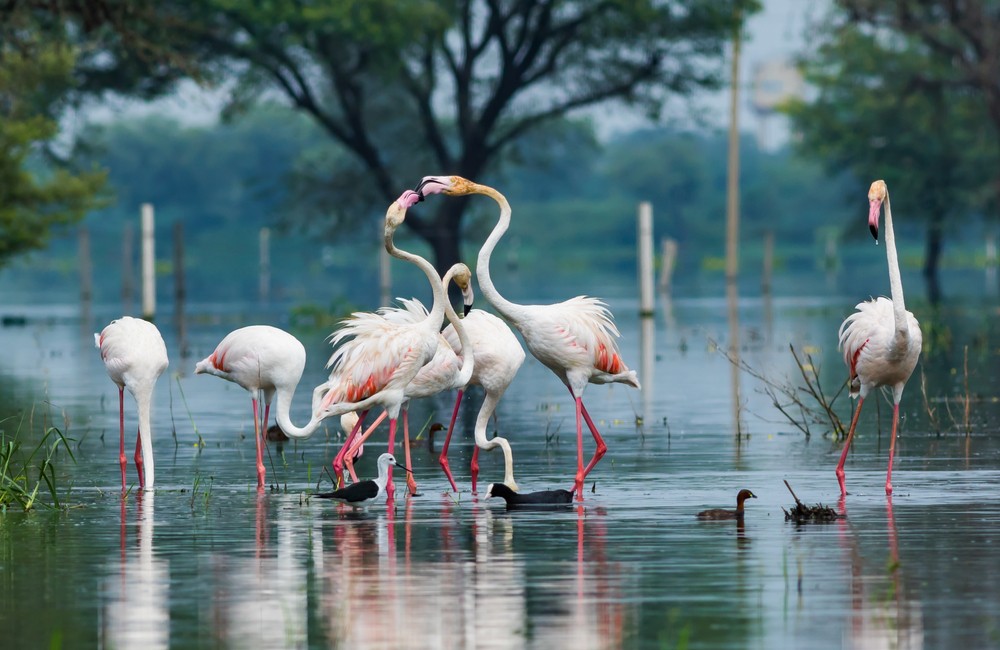
Keoladeo National Park | #35 of 40 in the list of UNESCO World Heritage Sites in India 2021
Popularly known as Bharatpur Bird Sanctuary, Keoladeo National Park is home to over 350 species of birds, 380 types of plants, 50 species of fish and about 30 mammals. The birdwatching paradise was given the UNESCO World Heritage Site tag in 1985. Spread over an area of 2783 hectares, the landscape of the national park is a combination of woodlands, woodland swamps, dry grasslands and wetlands.
The national park looks particularly stunning during the winter months when about 364 species of wintering birds come here in large numbers from Turkmenistan, Afghanistan, China and Serbia. The popular species of birds here include Siberian cranes, geese, eagles, ducks, hawks, wagtails, stints, pipits, wheatears, and flycatchers. Tourists can take a jeep ride or rickshaw safari to spot different birds and animals here.
- Location: Bharatpur, Rajasthan
- Best Time to Visit: August to February
- Timings:
- Summer: 6:00 AM to 6:00 PM
- Winter: 6:30 AM to 5:00 PM
- Bird Safari Timings: 8:00 AM to 5:00 PM
- The national park is closed from June 15 to September 15
- Time Required: 4-5 hours
- Entry Fee (per person):
- Indians: INR 50
- Foreigners: INR 400
- Extra charges for rickshaws, tongas and boats. Private vehicles are strictly prohibited inside the sanctuary
36. Great Himalayan National Park, Himachal Pradesh
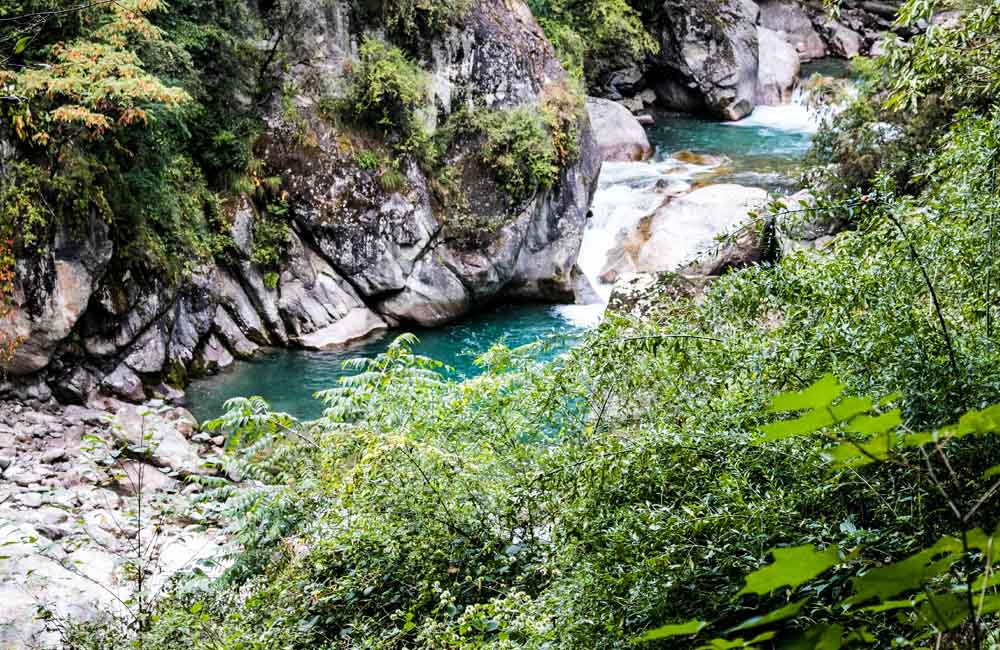
Great Himalayan National Park | #36 of 40 in the list of UNESCO World Heritage Sites in India 2021
Situated in the Kullu region of Himachal Pradesh, Great Himalayan National Park (GHNP) is home to an impressive variety of flora and fauna. It has over 180 species of birds, 30 species of mammals and 375 species of flora. Himalayan brown bear, white-bellied musk deer, snow leopard, blue sheep, Himalayan Tahr, and the western tragopan are some of the rare species found here. The alpine meadows, alpine peaks and riverine forests distinguish this national park from the rest and make it one of the most scenic national parks in the country.
GHNP is spread over an area of about 1171 sq. km and includes the upper mountain glacial and snowmelt water source origins of different rivers. The national park also supports a range of plant life, such as pines, horse chestnuts, alpine herbs and junipers. Considering its important role in biodiversity and conservation, the national park was included in the list of UNESCO World Heritage Sites in India in 2014.
- Location: Forest Office Road, Shamshi, Himachal Pradesh
- Best Time to Visit: March to November
- Timings: 24×7
- Time Required: 3-4 hours
- Entry Fee (per person):
- Indians: INR 50
- Foreigners: INR 200
- Indian Students: INR 30
- Foreign Students: INR 100
- Extra charges for camping
37. Nanda Devi and Valley of Flowers National Parks, Uttarakhand
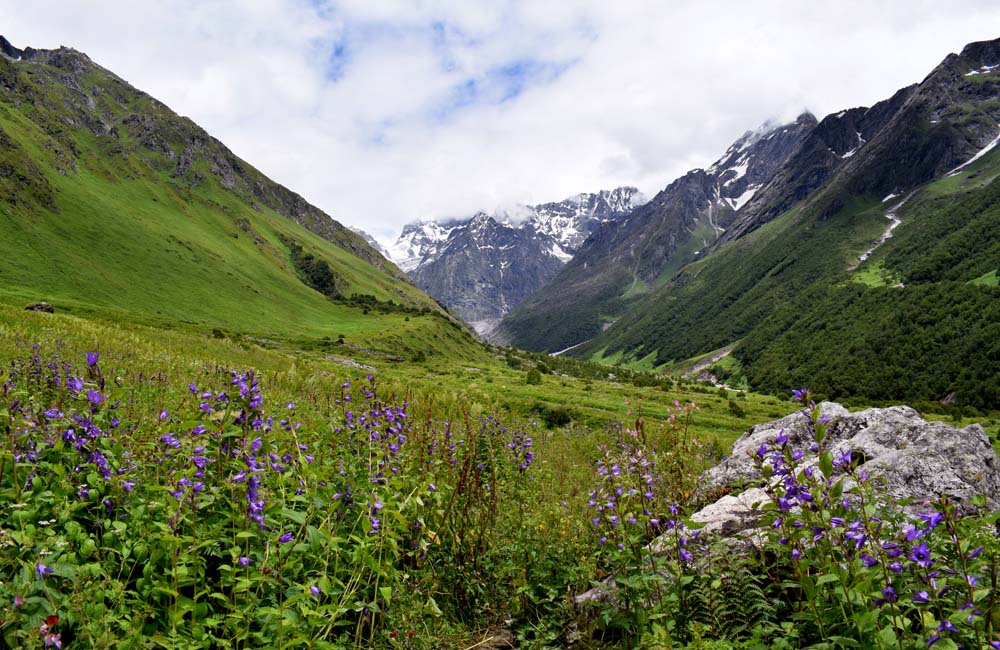
Valley of Flowers National Parks | #37 of 40 in the list of UNESCO World Heritage Sites in India 2021
Located near Nanda Devi, the second-highest mountain peak in India, Nanda Devi National Park is one of the most amazing wilderness areas in the Himalayas. This quaint and scenic habitat, with an area of 630 sq. km., is known for its biodiversity, thanks to the range of flora and fauna found here, including some rare and exotic ones. From birds and animals to plants, trees and butterflies, the national park houses them all.
Spread over an area of 87 sq. km., Valley of Flowers is known for its stunning meadows of endemic alpine flowers. The national park is set against the backdrop of the majestic Himalayan ranges and offers ethereal views. While a major part of the park is covered by around 600 species of exotic flowers, such as orchids, daisies and poppies, certain parts are occupied by sub-alpine forests. The national park is also home to the Himalayan weasel, grey langur, red fox, snow leopard, and other rare wildlife species.
Both these national parks are counted among the most beautiful and biodiverse areas in the Himalayas. Nanda Devi National Park was declared a UNESCO World Heritage Site in 1988. However, in 2005, the area was expanded to include Valley of Flowers National Park.
- Location: Chamoli district, Uttarakhand
- Best Time to Visit: May to October
- Timings: 8:00 AM to 5:00 PM; 7 days a week
- Time Required: 1-2 days
- Entry Fee (per person for 3 days):
- Nanda Devi National Park:
- Indians: INR 50
- Foreigners: INR 150
- Valley of Flowers:
- Indians: INR 150
- Foreigners: INR 600
38. Sundarbans National Park, West Bengal
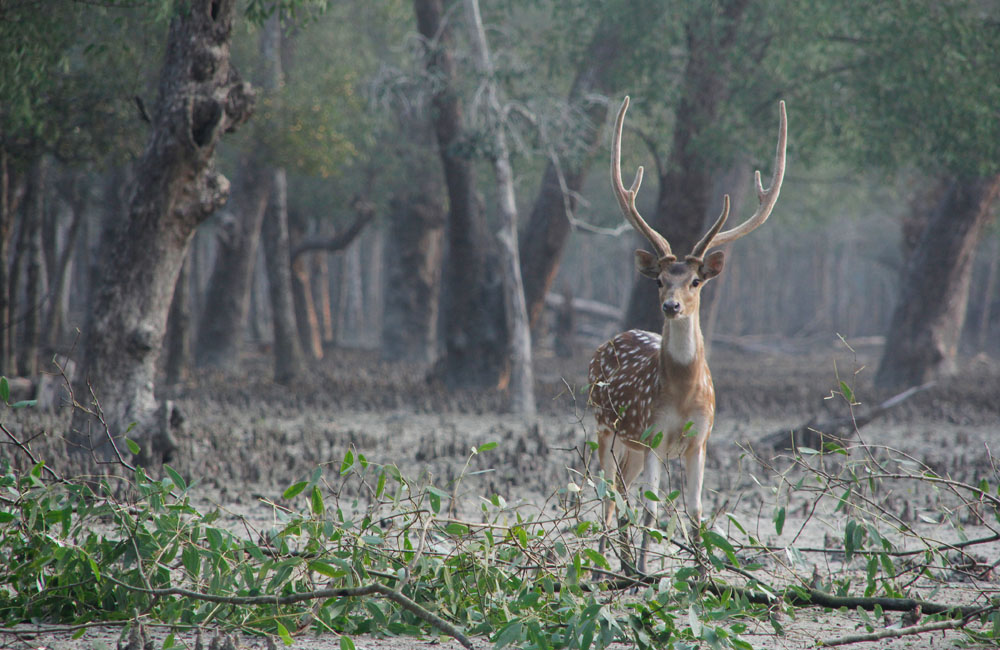
Sundarbans National Park | #38 of 40 in the list of UNESCO World Heritage Sites in India 2021
Home to an interesting array of flora and fauna, Sundarbans National Park is a popular Tiger Reserve as well as a Biosphere Reserve. The national park is particularly famous for Royal Bengal Tigers. In fact, the largest population of Royal Bengal tigers is found here. And that’s not all, it also serves as a natural habitat for a variety of birds, saltwater crocodiles, wild boars, spotted deer, Gangetic dolphins, fishing cats, flying foxes, king crabs and many more mammals, reptiles and amphibians.
Located in the Sundarbans delta, this national park is named after the Sundari trees that are found here in plenty. These trees are also dominant in the dense mangrove forests that cover Sundarbans. A perfect example of natural beauty and biodiversity, Sundarbans National Park was added to the list of UNESCO World Heritage Sites in India in 1987.
- Location: 24 Parganas district, West Bengal
- Best Time to Visit: October to March
- Timings:
- Monday – Friday: 8:00 AM to 6:00 PM
- Saturday: 10:00 AM to 4:00 PM
- Closed on Sundays
- Time Required: 1-2 days
- Entry Fee (per person):
- Indians: INR 60
- Foreigners: INR 200
- Extra charges for a boat ride, camera and guide
Suggested Read: Places To Visit in West Bengal
39. Western Ghats
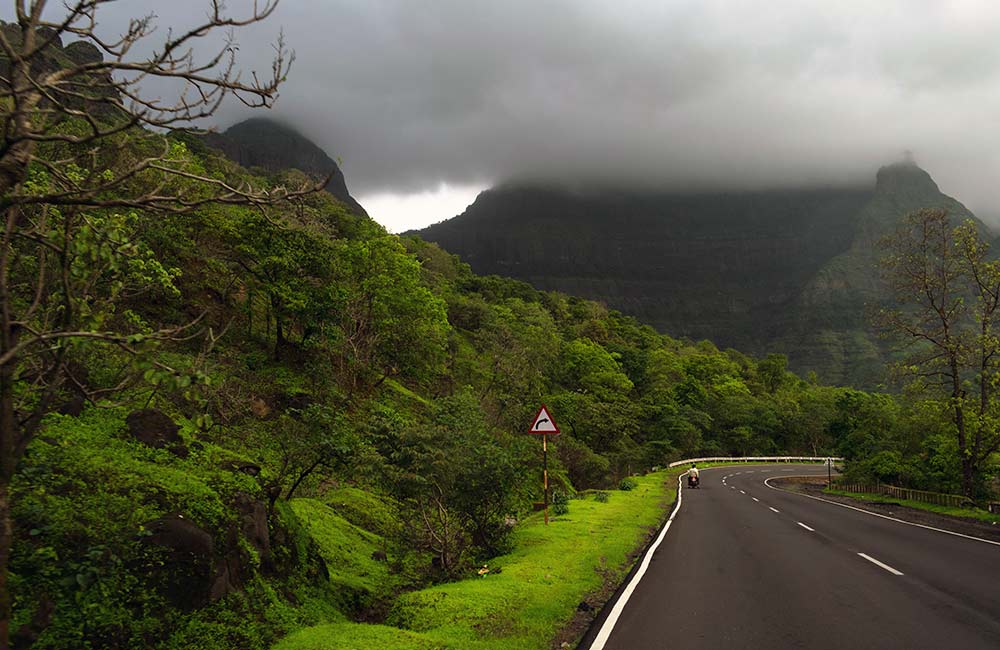
Western Ghats | #39 of 40 in the list of UNESCO World Heritage Sites in India 2021
Spread across seven states, Western Ghats Mountain Range was declared a world heritage site by UNESCO in 2012. It is dotted with many wildlife sanctuaries, reserve forests and national parks, and is counted among the eight hottest hotspots of biological diversity in the world. The Western Ghats starts from the southern tip of the country i.e., Kanyakumari, and runs through Tamil Nadu, Kerala, Karnataka, Goa and Maharashtra, before ending in Gujarat.
Covering an area of 160000 sq. km., this majestic mountain range includes Agasthyamalai Sub-Cluster (Kerala), Periyar Sub-Cluster (Kerala), Anamalai Sub-Cluster (Kerala), Nilgiri Sub-Cluster (Tamil Nadu), Talakaveri Sub-Cluster (Karnataka), Kudremukh Sub-Cluster (Karnataka) and Sahyadri Sub-Cluster (Maharashtra). As one of the hottest biodiversity hotspots, the Western Ghats reportedly has over 7400 species of flowering plants, 1810 species of non-flowering plants, 140 species of mammals, 180 amphibian species, 500 bird species, 600 species of insects and around 290 species of freshwater fish. Out of these, over 320 are globally threatened species. No wonder the biodiversity of the Western Ghats is often compared with the Amazon Rainforest.
- Location: Western coast of India
- Best Time to Visit: October to March
Mixed
40. Khangchendzonga National Park, Sikkim
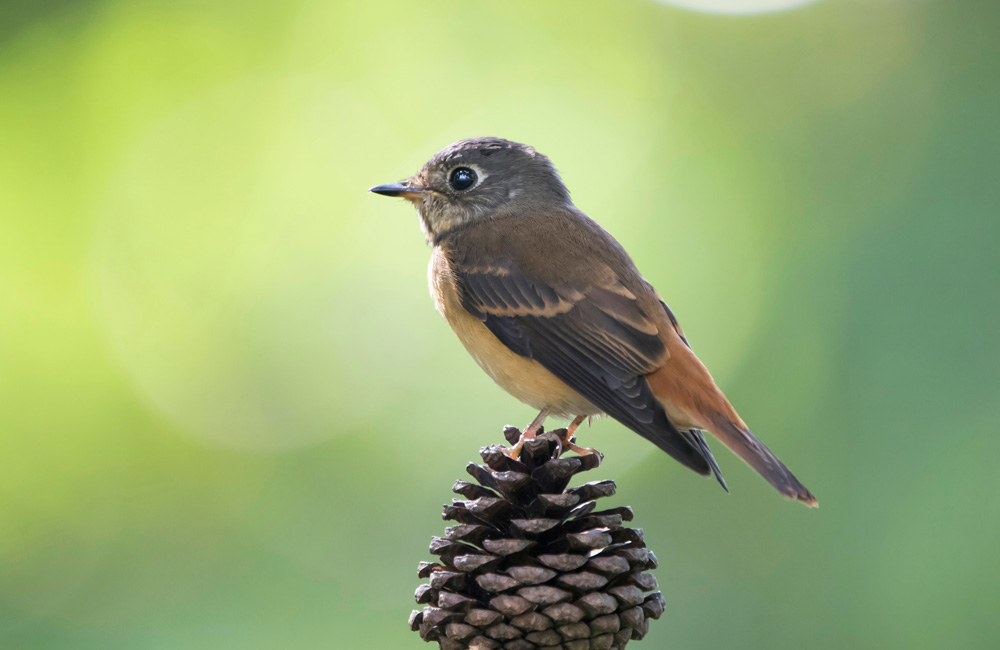
Khangchendzonga National Park | #40 of 40 in the list of UNESCO World Heritage Sites in India 2021
Nestled in the heart of the Himalayan ranges, this high-altitude national park is the first ‘mixed heritage’ site in the country. It is popularly known as Kanchenjunga National Park and was inscribed on the list ofUNESCO World Heritage Sites in India in 2016. The national park is spread over an area of 850 sq. km. and has a varying elevation of 1829 m to over 8550 m. It includes a unique range of valleys, plains, glaciers, lakes and snow-capped mountains with forests. Mount Kanchenjunga, the world’s third highest peak, is also a part of the national park.
Khangchendzonga National Park boasts unique biodiversity and is known for many rare and endemic species of flora and fauna. Apart from oak, birch, maple, willow and fir, the park has many herbs and medicinal plants. It also serves as a natural habitat for many mammals, reptiles, and over 550 species of birds. These include snow leopard, sloth bear, red panda, Himalayan blue sheep and musk deer, Russell viper, snow pigeon, green pigeon, and Asian emerald cuckoo. Khangchendzonga National Park is a paradise for trekkers as well, thanks to its diverse landscape and the spectacular views it offers.
- Location: North Sikkim
- Best Time to Visit: March to May, September to mid-October
- Timings: 24 hours (Closed on Sundays)
- Time Required: 2-3 day
- Entry Fee (per person) for the first 7 days:
- Indians: INR 350
- Foreigners: INR 560
- Students: INR 80
- Extra charges for additional days, tent, guide and camera
Home to as many as 40 amazing UNESCO World Heritage Sites, India proudly stands in the sixth position in the world, when it comes to the number of heritage sites. All these architectural marvels and natural wonders are unique in their own way and promise a wonderful experience to tourists. Has our list of UNESCO World Heritage Sites in India fuelled your desire to embark on a trip? So, what are you waiting for? Chalk out a workable itinerary, books flights and hotels in advance, and pack your bags to explore these stunning cultural and natural sites.


